Lesson 04: Combined breakage
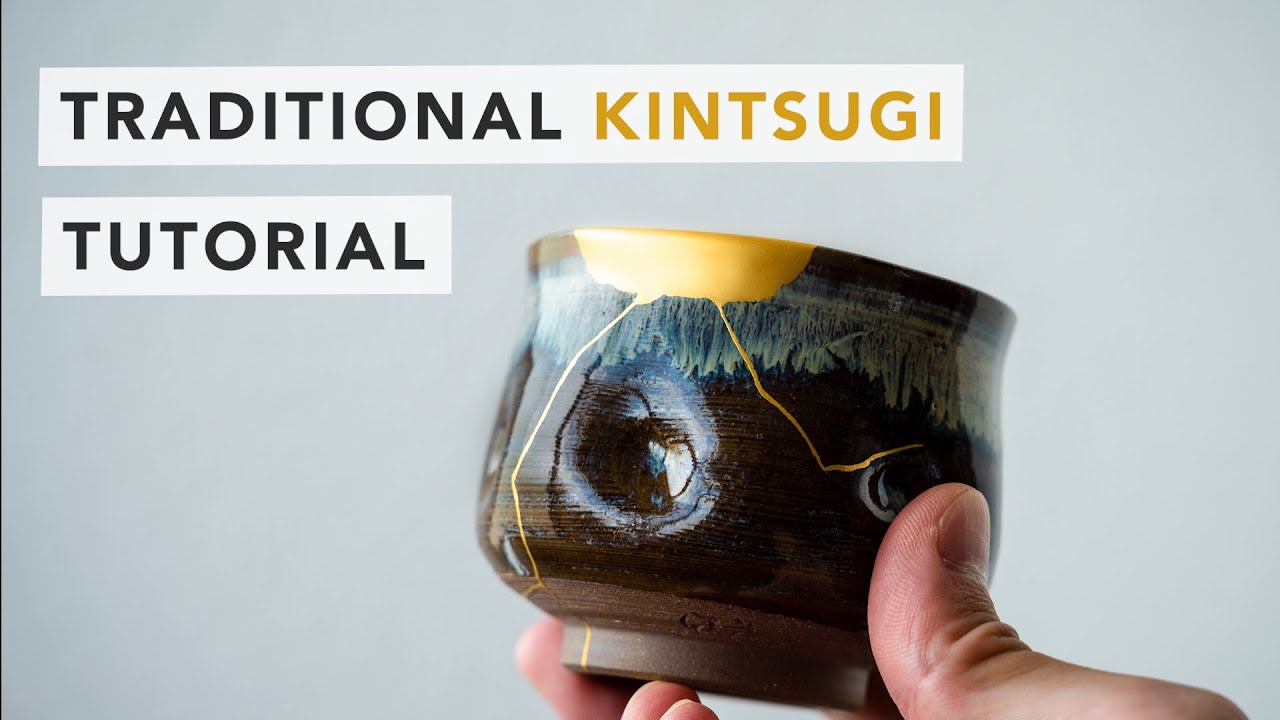

*Wear gloves during the entire process, as urushi can cause severe rash.
*We assume no responsibility for any health hazards.
1. Medome
Take measures to prevent dirt before starting repairs.
Porcelain is not much of a concern, but pottery may be prone to urushi seeping into the interior, even if the glaze is well glazed.
As you can see, staining is particularly visible on white pottery.
These stains can be prevented to some extent by doing "Medome".
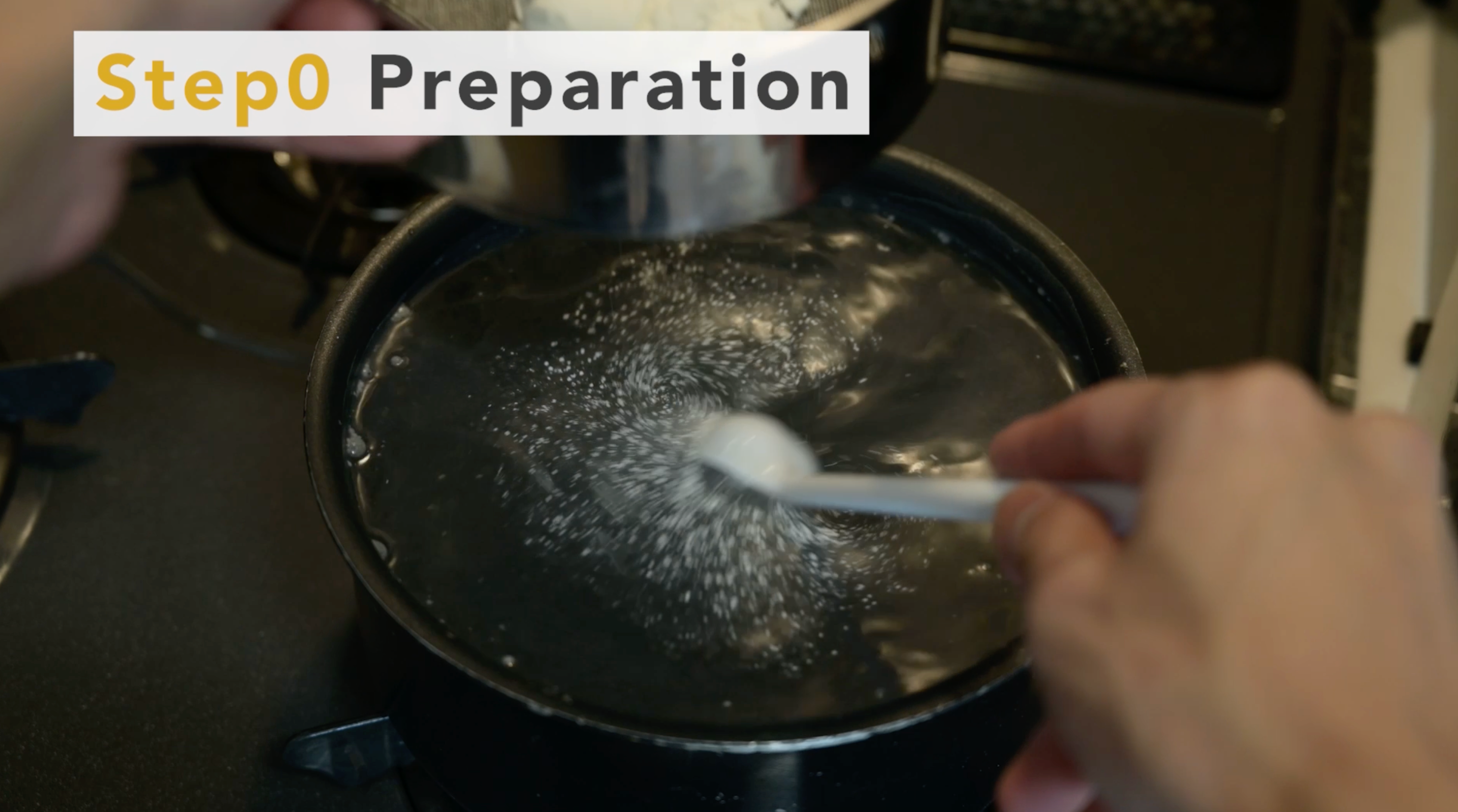
First, fill the pot with enough water to fully soak the pottery.
Next, add cake flour.
Put in a ratio of 20 g of flour to 1000 ml of water.
Use a sieve to avoid lumps.
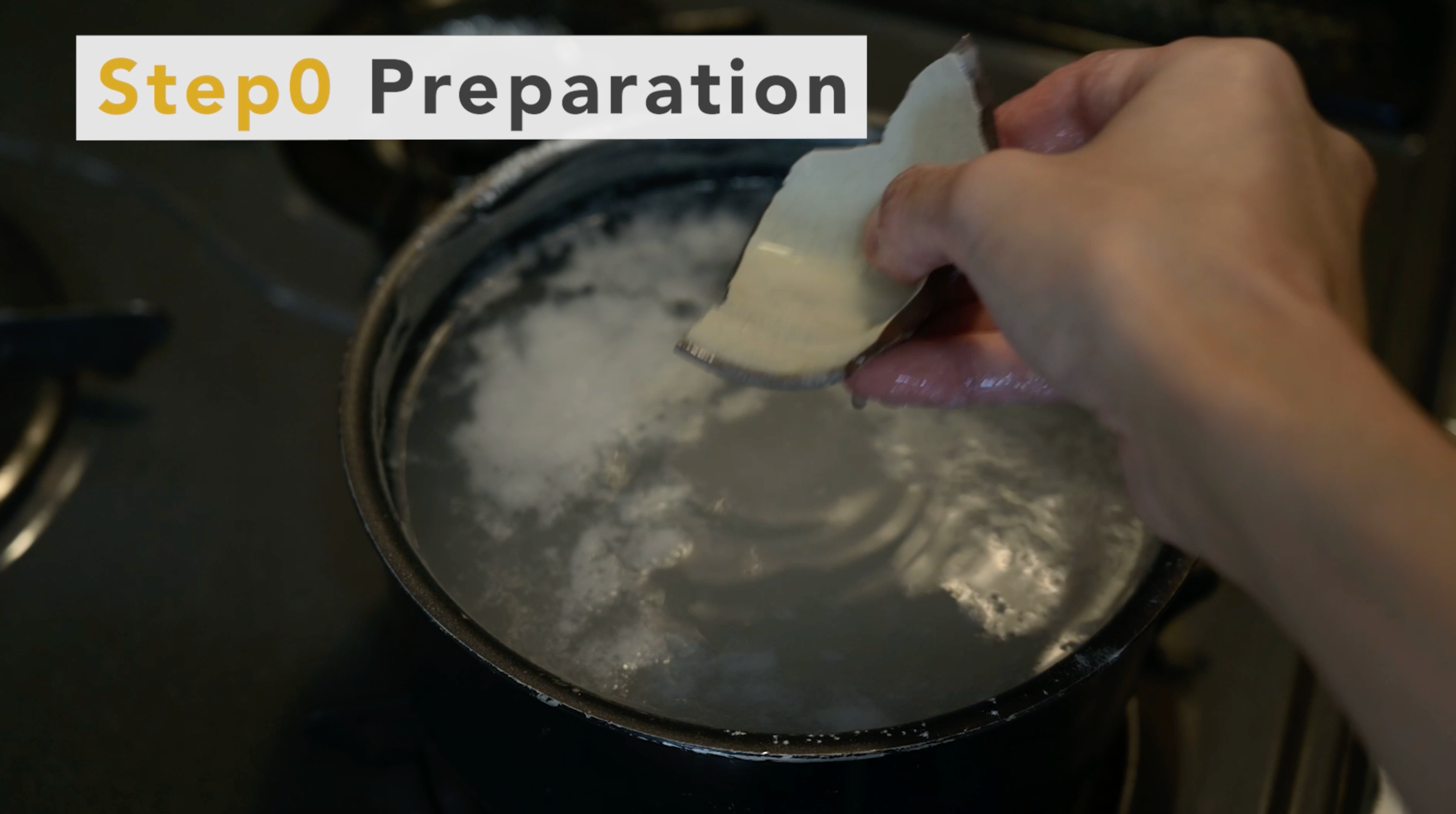
Then, put in the pottery to be repaired and bring to a boil over low to medium heat.
Stir to prevent the flour from settling to the bottom.
Once it boils, let it boil for around 20 minutes on low heat.
After 20 minutes, turn off the heat and wait a few hours for the water to cool.

When the water reaches room temperature, remove the pottery.
Wash with water until the sliminess is removed.
Leave overnight to dry thoroughly.
Now "Medome" is complete.
*Wear gloves during the entire process, as urushi can cause severe rash.
*We assume no responsibility for any health hazards.
1. Medome
Take measures to prevent dirt before starting repairs.
Porcelain is not much of a concern, but pottery may be prone to urushi seeping into the interior, even if the glaze is well glazed.
As you can see, staining is particularly visible on white pottery.
These stains can be prevented to some extent by doing "Medome".
First, fill the pot with enough water to fully soak the pottery.
Next, add cake flour.
Put in a ratio of 20 g of flour to 1000 ml of water.
Use a sieve to avoid lumps.
Then, put in the pottery to be repaired and bring to a boil over low to medium heat.
Stir to prevent the flour from settling to the bottom.
Once it boils, let it boil for around 20 minutes on low heat.
After 20 minutes, turn off the heat and wait a few hours for the water to cool.
When the water reaches room temperature, remove the pottery.
Wash with water until the sliminess is removed.
Leave overnight to dry thoroughly.
Now "Medome" is complete.





1. Apply black urushi
This broken pottery has a combination of chips and cracks.
First, fill the cracks.
In the basic tutorial, we soaked raw urushi, but this time we will use black urushi.
Black urushi is more viscous and less likely to cause staining.
Apply black urushi to trace the line of cracks.
Wipe the brush tip thoroughly with ethanol first before use.
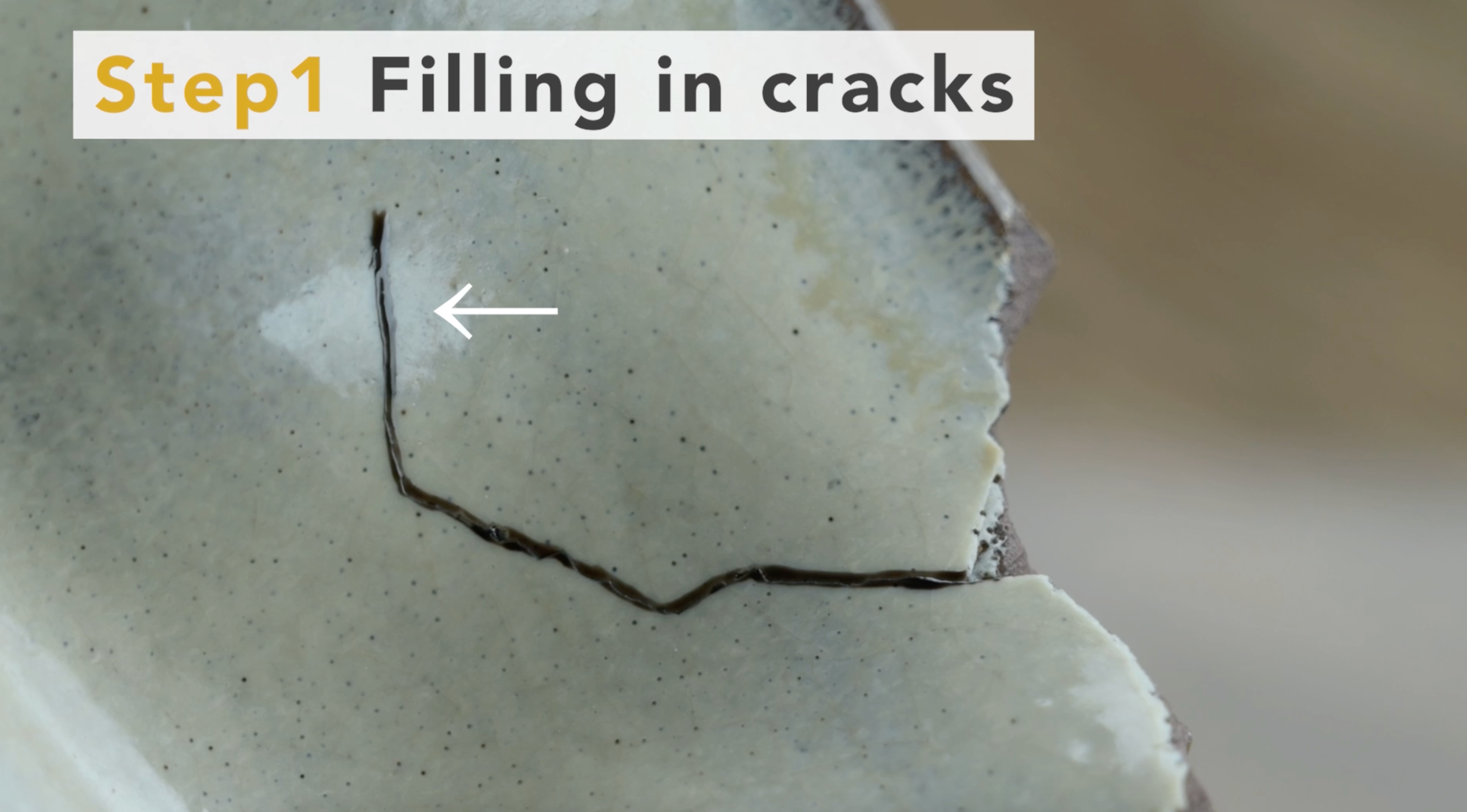
The black streak visible in the center of the line is a groove in the crack that has not been filled.
These areas should be painted again.
If the grooves still remain, leave them as they are.
Deep cracks should be filled in several coats, as multiple coats of black urushi may cause staining.
2. Wait about few days to harden
When you have also finished filling the other side., store it with temperature around 25°C and humidity around 75%.
- note
- One method is to place wet towels in cardboard boxes to maintain the right humidity for storage.
- The temperature should also be kept from getting cold by using air conditioning.
- In particular, urushi may not harden properly if the temperature falls below 20 degrees Celsius, so be careful to control both temperature and humidity after working on this and subsequent steps.
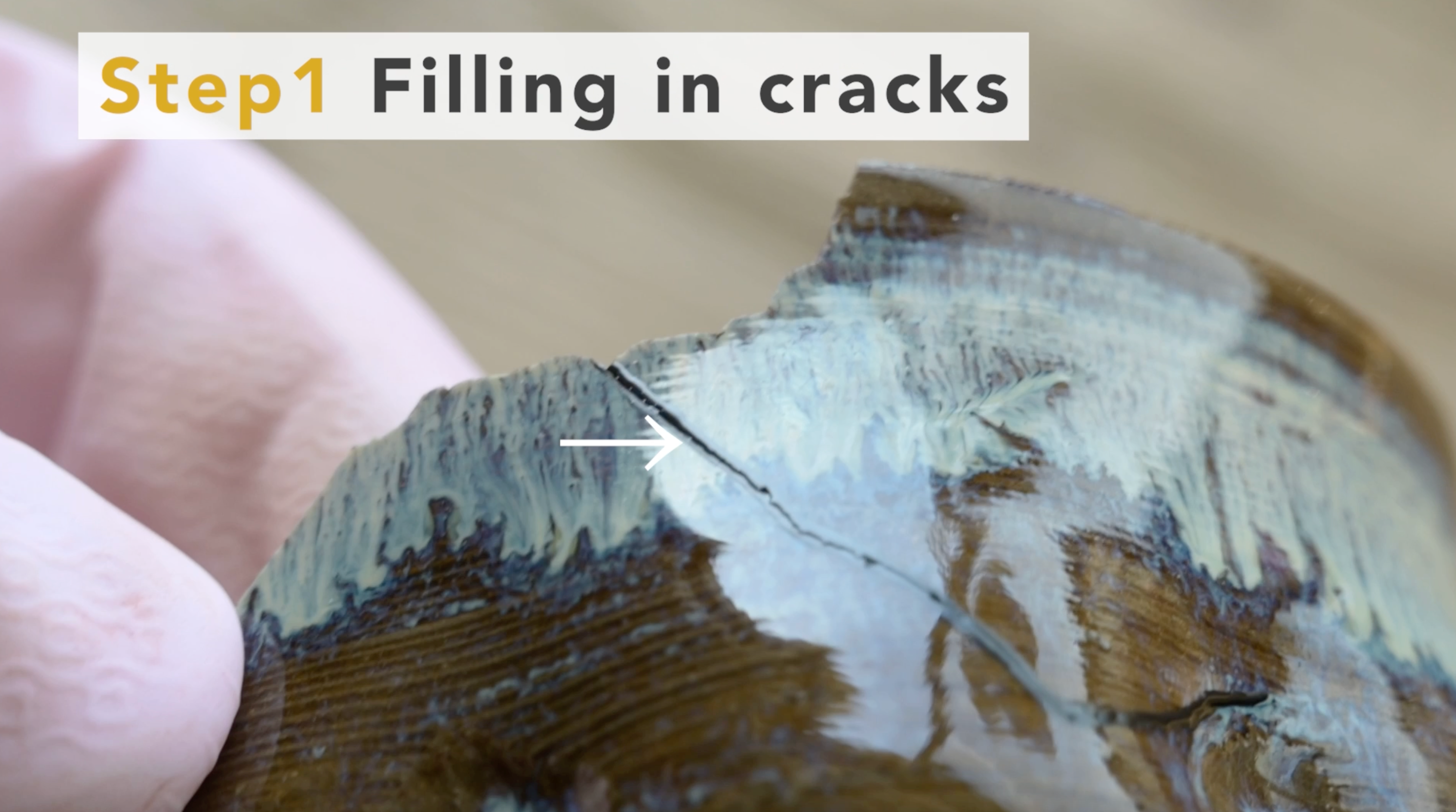
3. Apply black urushi again
After a few days and after urushi hardened, the black streak visible in the center of the line is a groove in the crack that has not been filled.
If these grooves are visible, they need to be applied again.
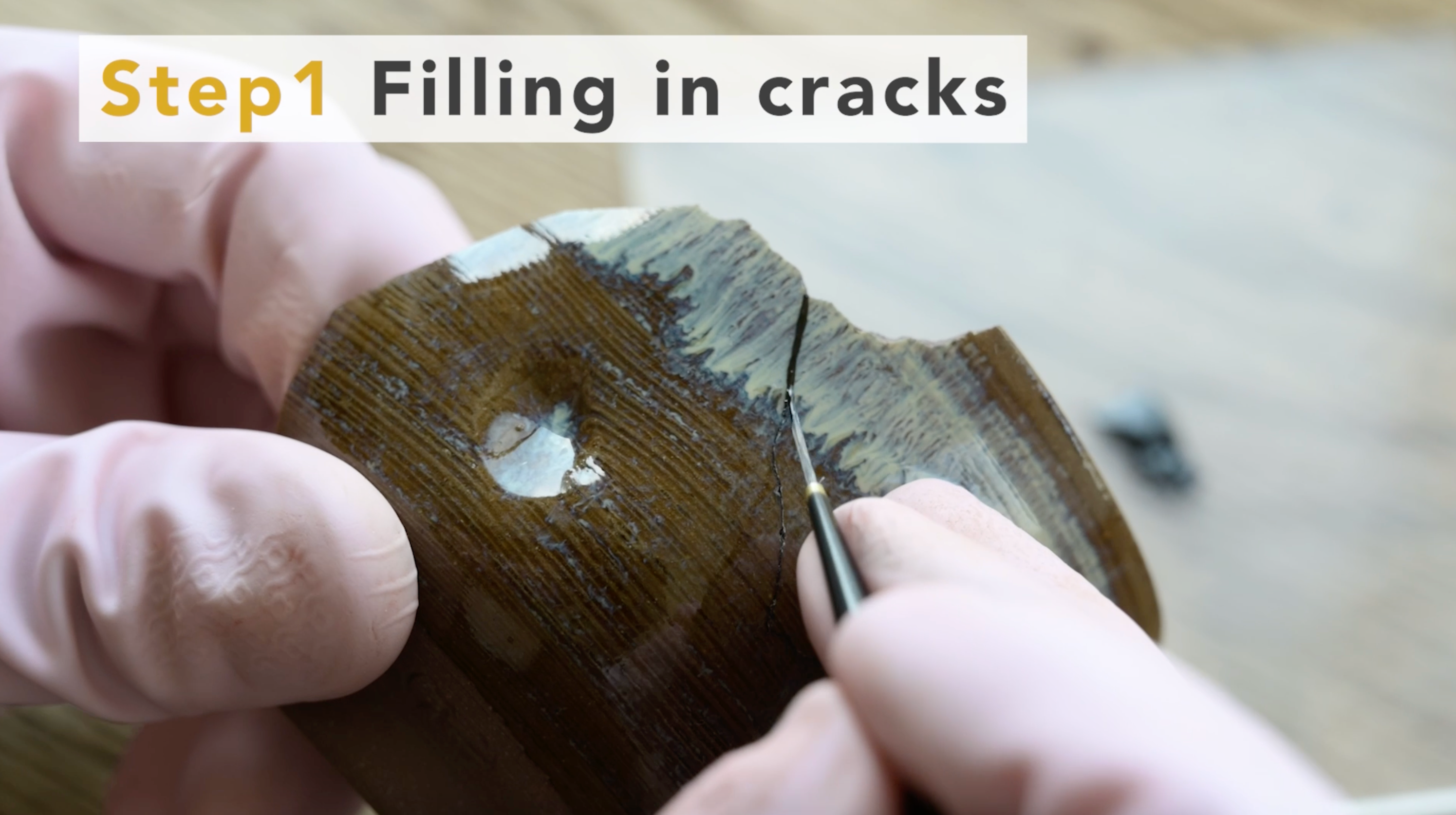
Before doing so, use a cutter to remove the previous coating.
Once the excess black urushi has been scraped off, apply black urushi again.
Repeat this process until the black streaks are no longer visible after hardening.
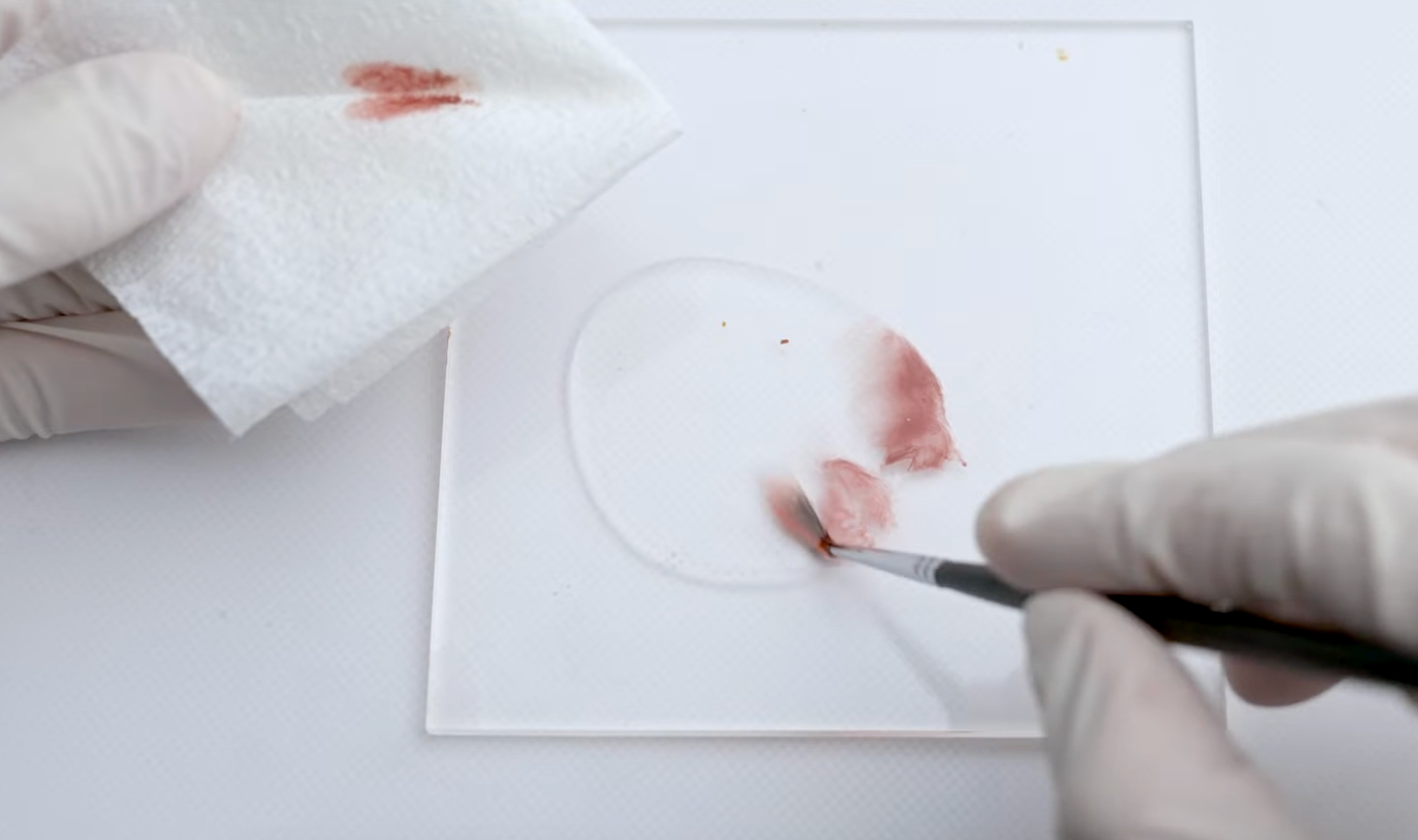
How to wash brushes
Wash brushes after use with vegetable oil such as rapeseed oil.
Dip the brush into the oil that has been put out on the acrylic plate and wipe it off with a tissue.
Repeat this process until there is almost no color on the tissue.
Finally, put the cap on and store the brush with a little oil remaining on it.
Otherwise, the brush tip may harden.
Finally, completely wipe off any oil remaining on the acrylic plate with ethanol.
If even a small amount of oil is left, it may mix with the oil and prevent the urushi from hardening next time.
1. Apply black urushi
This broken pottery has a combination of chips and cracks.
First, fill the cracks.
In the basic tutorial, we soaked raw urushi, but this time we will use black urushi.
Black urushi is more viscous and less likely to cause staining.
Apply black urushi to trace the line of cracks.
Wipe the brush tip thoroughly with ethanol first before use.
The black streak visible in the center of the line is a groove in the crack that has not been filled.
These areas should be painted again.
If the grooves still remain, leave them as they are.
Deep cracks should be filled in several coats, as multiple coats of black urushi may cause staining.
2. Wait about few days to harden
When you have also finished filling the other side., store it with temperature around 25°C and humidity around 75%.
- note
- One method is to place wet towels in cardboard boxes to maintain the right humidity for storage.
- The temperature should also be kept from getting cold by using air conditioning.
- In particular, urushi may not harden properly if the temperature falls below 20 degrees Celsius, so be careful to control both temperature and humidity after working on this and subsequent steps.
3. Apply black urushi again
After a few days and after urushi hardened, the black streak visible in the center of the line is a groove in the crack that has not been filled.
If these grooves are visible, they need to be applied again.
Before doing so, use a cutter to remove the previous coating.
Once the excess black urushi has been scraped off, apply black urushi again.
Repeat this process until the black streaks are no longer visible after hardening.
How to wash brushes
Wash brushes after use with vegetable oil such as rapeseed oil.
Dip the brush into the oil that has been put out on the acrylic plate and wipe it off with a tissue.
Repeat this process until there is almost no color on the tissue.
Finally, put the cap on and store the brush with a little oil remaining on it.
Otherwise, the brush tip may harden.
Finally, completely wipe off any oil remaining on the acrylic plate with ethanol.
If even a small amount of oil is left, it may mix with the oil and prevent the urushi from hardening next time.





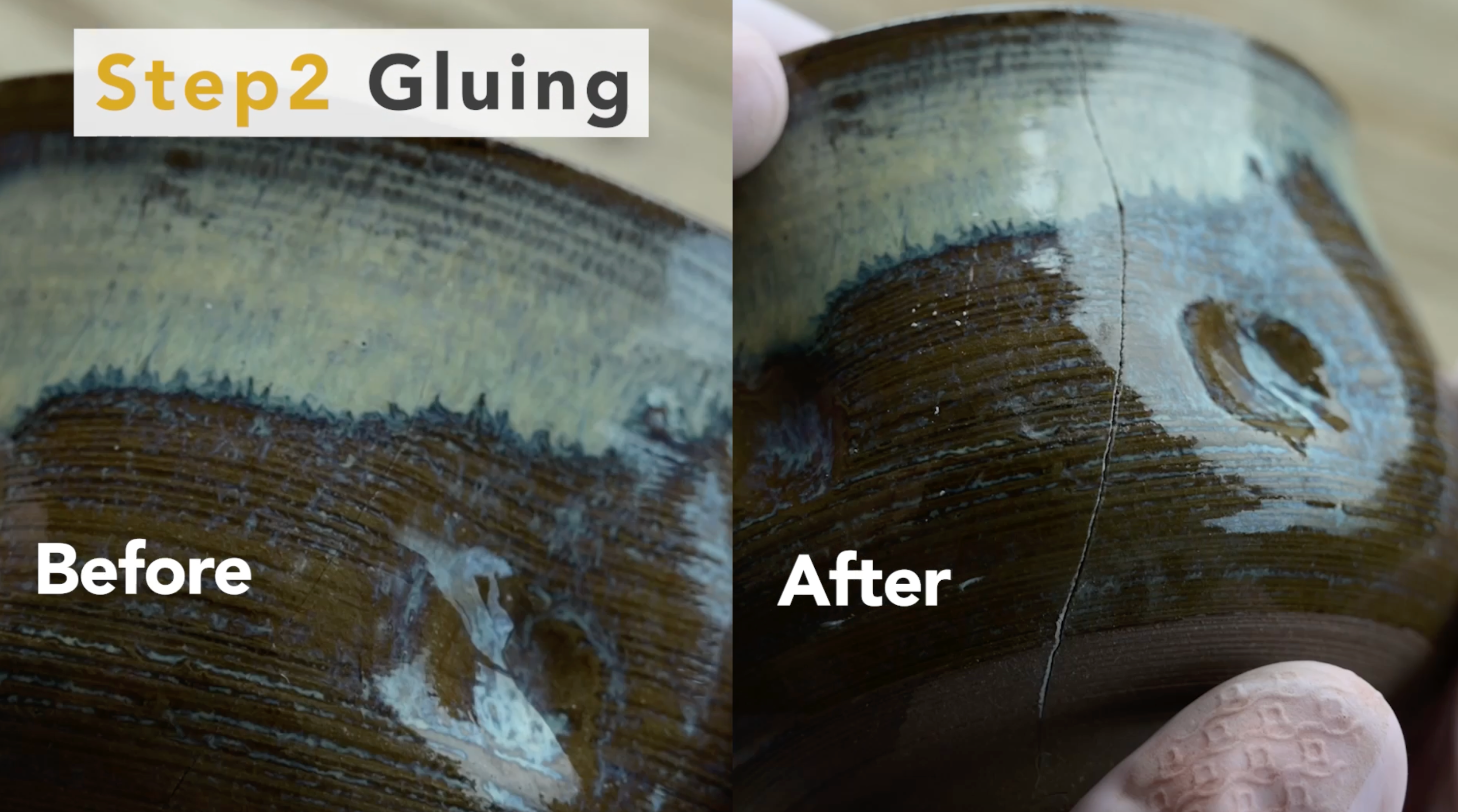
1. Chamfering of the broken parts
First, sand the corners of the pieces with a diamond file as in the basic tutorial.
Chamfering creates a groove in the seams, which allows the urushi to settle on the seams.
Be careful not to use too much force, as it will chip the ceramics.
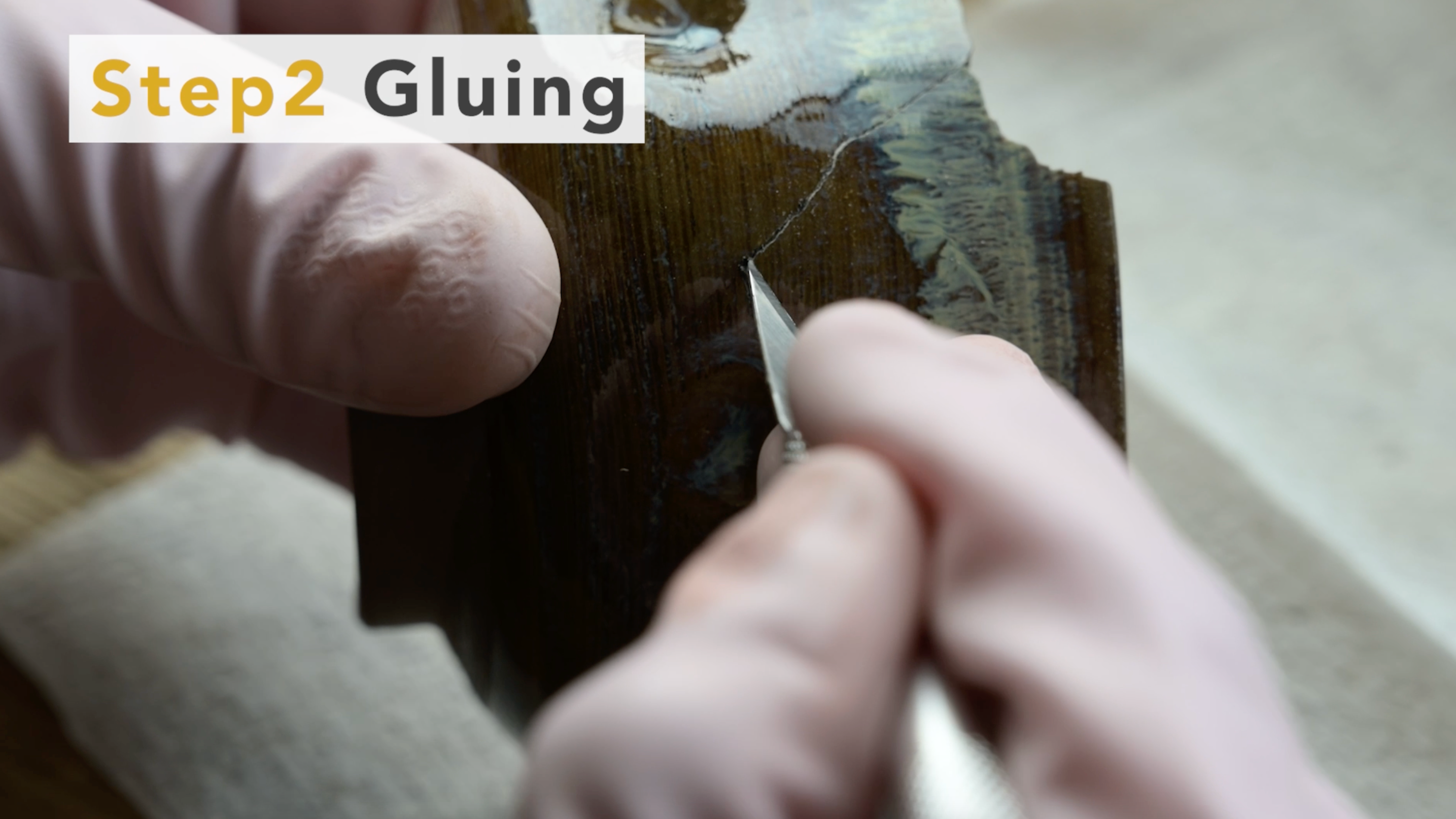
A groove is also needed at the cracks.
Use a cutter to make a groove as in the basic tutorial.
It is easy to make the width of the groove with the cutter blade facing sideways.

2. Making "Mugi-urishi"
Once you have finished beveling the pieces, glue the pieces together.
For gluing, a mixture of cake flour, water, and raw urushi called "Mugi-Urushi" is used.
- Ingredients for Mugi-Urushi
- Cake flour: 1 grated spoonful
- Water: 1 grated spoonful (a little less)
- Raw urushi: 2 grated spoonful
- ※With 0.1ml measuring spoon
First, mix cake flour and water on an acrylic board and knead until the mixture resembles bread dough.
If it does not resemble bread dough and is too watery, remake it again.
Then add raw urushi and knead well with a spatula.
When the surface becomes smooth and stretchy, "Mugi-Urushi" is completed.
If it does not stretch well enough, add raw urushi little by little to adjust it.

3. Prepare masking tapes
In advance, prepare shredded masking tape for use when gluing.
Depending on the size of the ceramics and the number of fragments, prepare about 10 pieces at a time.
(It is quite difficult to shred the tape while gluing)
Also, thin areas of glaze should be protected with masking tape in advance.
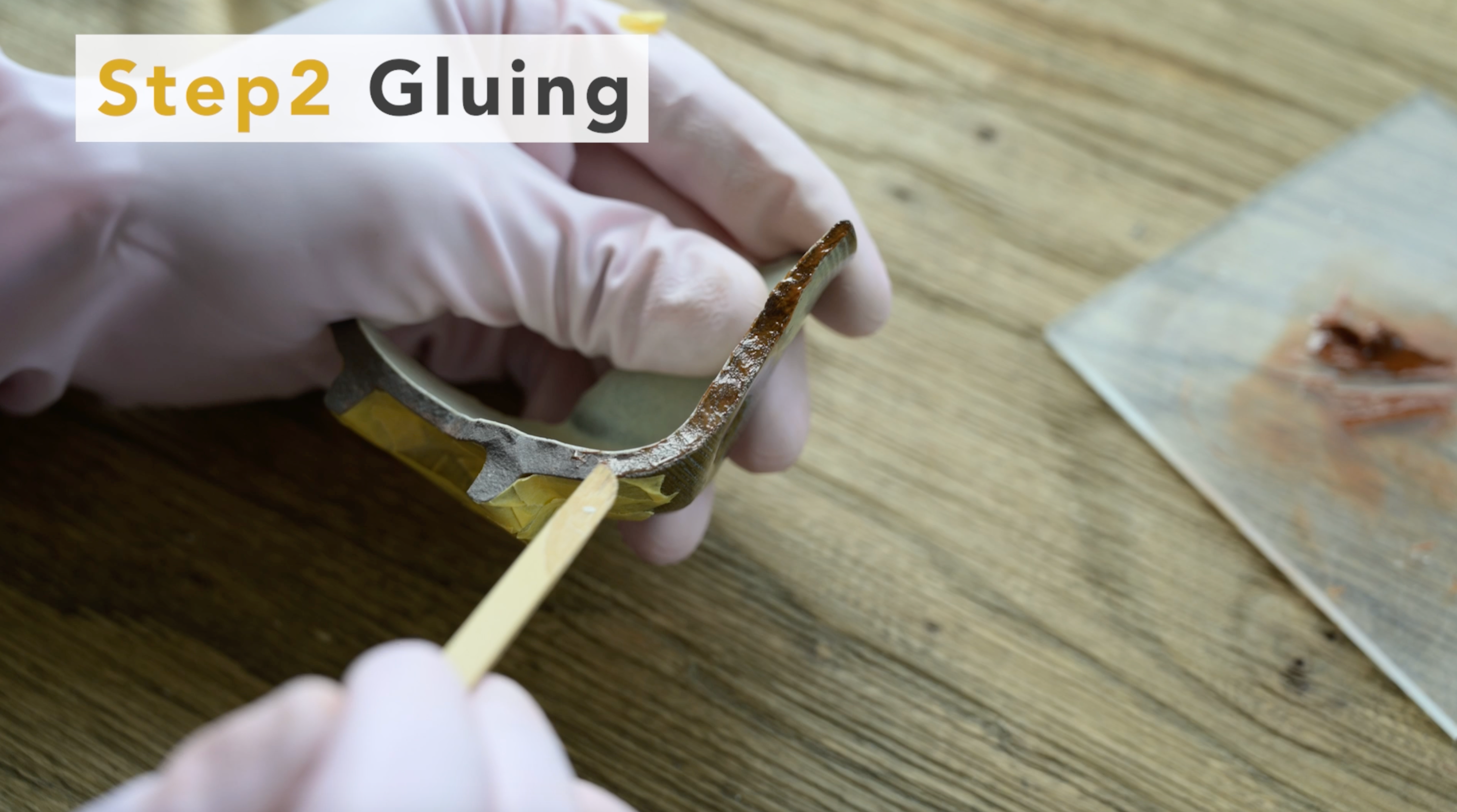
4. Glue pieces together
It is time to glue the pieces together.
Apply a thin layer of mugi-urushi to the cross section of the fragments.
*For ceramics with thin glaze or those which urushi is likely to bleed through, use masking tape to protect the area around the joints in advance.
After applying mugi-urushi to the cross sections of all the pieces, glue the pieces together.
The important thing is to glue and crimp them together precisely so that there is no misalignment.
Be careful not to create gaps or bumps.
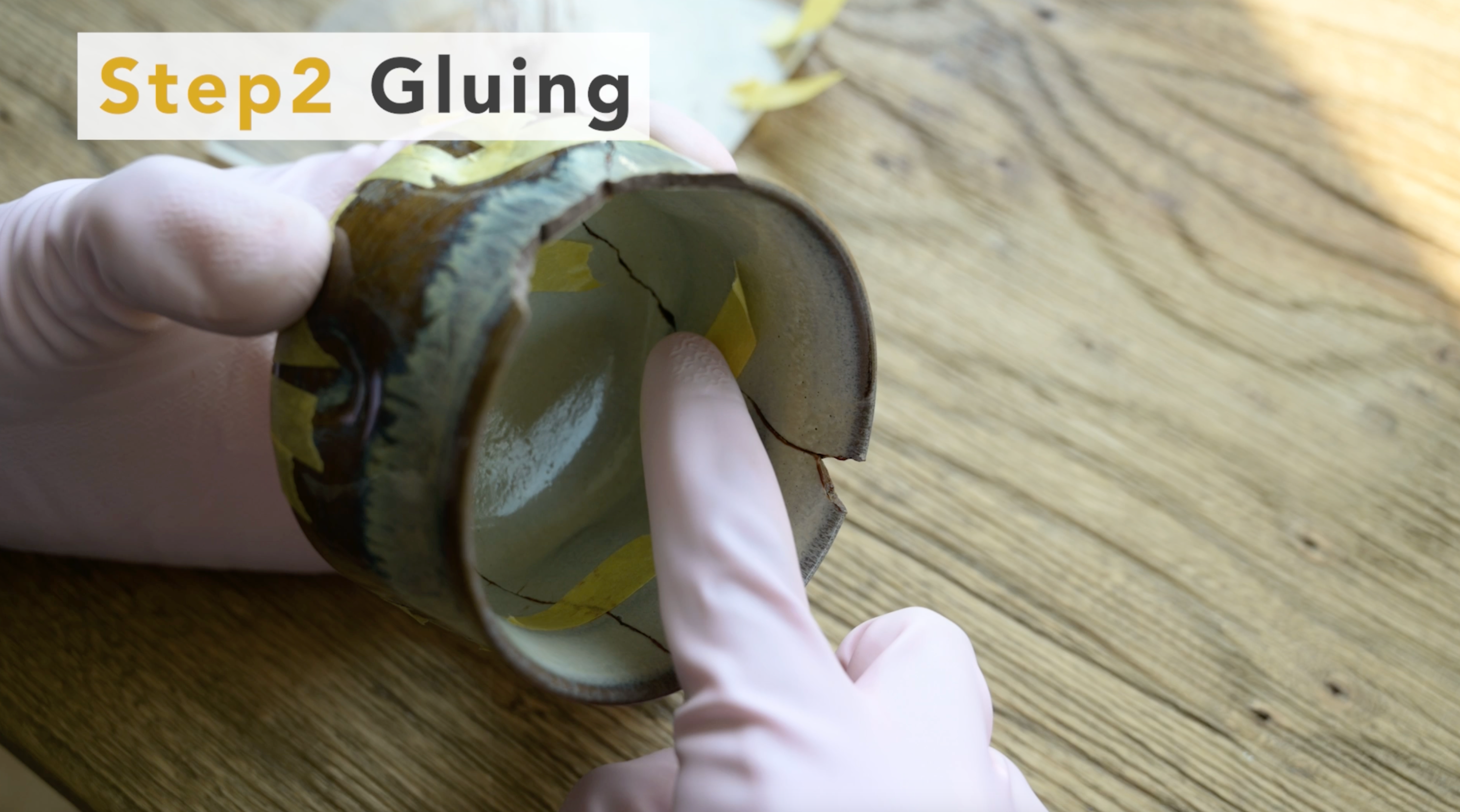
5. Fasten with masking tape
As soon as you have glued one of the pieces, apply masking tape to secure it.
This will prevent the pieces from shifting from each other until they are completely glued.
Once secured, glue the next piece of fragments.

6. Wait about 1 week for the mugi-urushi to harden
At this point, the gluing process has been completed. Wait about a week for the mugi-urushi to harden firmly.
Mugi urushi does not need much humidity to harden, but it may not harden sufficiently in dry areas, for example.
To be safe, keep it in a place with a humidity of around 70% and a temperature of around 25 degrees Celsius.
- note
- One method is to place wet towels in cardboard boxes to maintain the right humidity for storage.
- The temperature should also be kept from getting cold by using air conditioning.
- In particular, urushi may not harden properly if the temperature falls below 20 degrees Celsius, so be careful to control both temperature and humidity after working on this and subsequent steps.
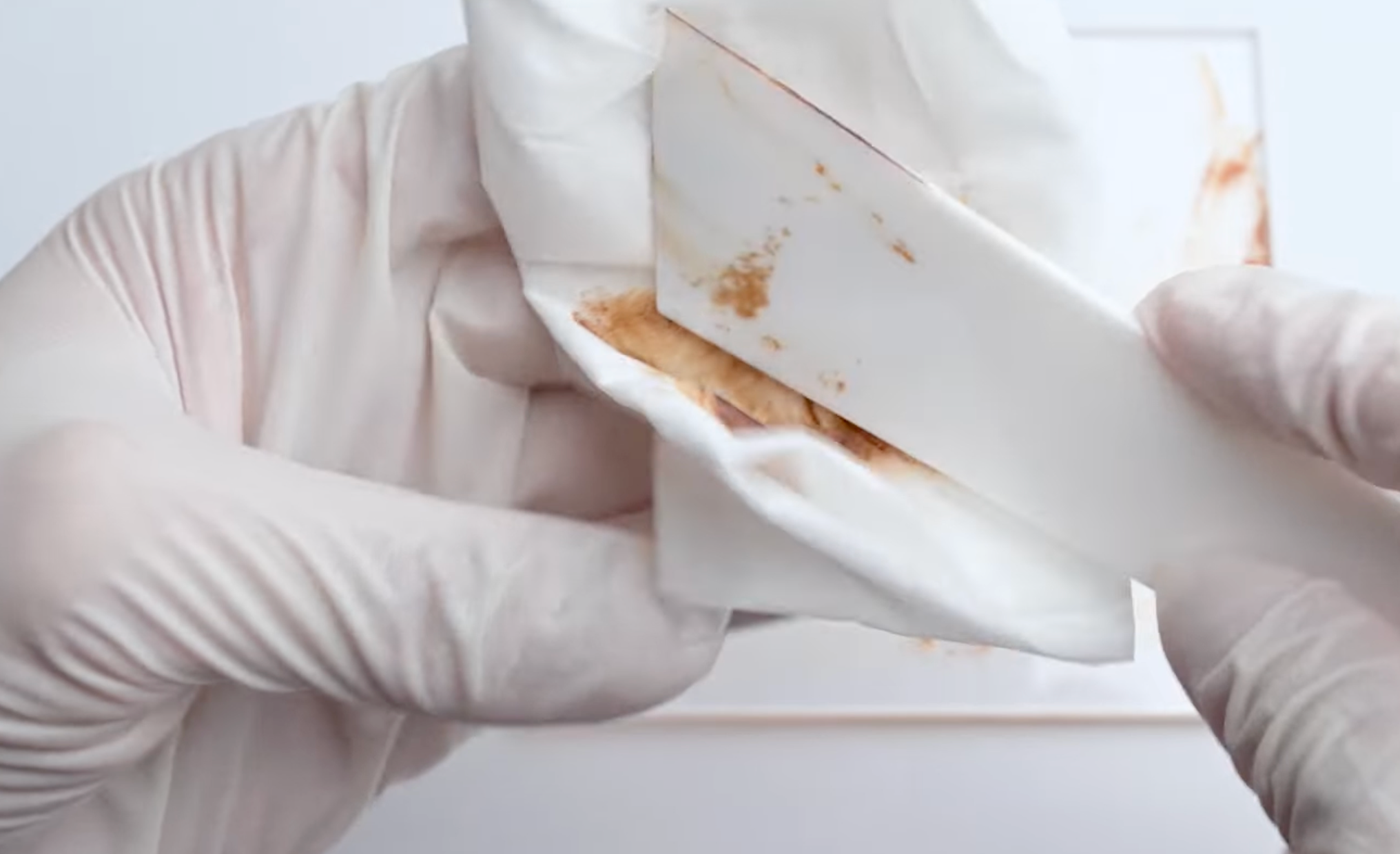
How to wash tools
Wipe off any tools with urushi using a tissue moistened with ethanol.
All tools except for the brush can be wiped off with ethanol.
1. Chamfering of the broken parts
First, sand the corners of the pieces with a diamond file as in the basic tutorial.
Chamfering creates a groove in the seams, which allows the urushi to settle on the seams.
Be careful not to use too much force, as it will chip the ceramics.
A groove is also needed at the cracks.
Use a cutter to make a groove as in the basic tutorial.
It is easy to make the width of the groove with the cutter blade facing sideways.
2. Making "Mugi-urishi"
Once you have finished beveling the pieces, glue the pieces together.
For gluing, a mixture of cake flour, water, and raw urushi called "Mugi-Urushi" is used.
- Ingredients for Mugi-Urushi
- Cake flour: 1 grated spoonful
- Water: 1 grated spoonful (a little less)
- Raw urushi: 2 grated spoonful
- ※With 0.1ml measuring spoon
First, mix cake flour and water on an acrylic board and knead until the mixture resembles bread dough.
If it does not resemble bread dough and is too watery, remake it again.
Then add raw urushi and knead well with a spatula.
When the surface becomes smooth and stretchy, "Mugi-Urushi" is completed.
If it does not stretch well enough, add raw urushi little by little to adjust it.
3. Prepare masking tapes
In advance, prepare shredded masking tape for use when gluing.
Depending on the size of the ceramics and the number of fragments, prepare about 10 pieces at a time.
(It is quite difficult to shred the tape while gluing)
Also, thin areas of glaze should be protected with masking tape in advance.
4. Glue pieces together
It is time to glue the pieces together.
Apply a thin layer of mugi-urushi to the cross section of the fragments.
*For ceramics with thin glaze or those which urushi is likely to bleed through, use masking tape to protect the area around the joints in advance.
After applying mugi-urushi to the cross sections of all the pieces, glue the pieces together.
The important thing is to glue and crimp them together precisely so that there is no misalignment.
Be careful not to create gaps or bumps.
5. Fasten with masking tape
As soon as you have glued one of the pieces, apply masking tape to secure it.
This will prevent the pieces from shifting from each other until they are completely glued.
Once secured, glue the next piece of fragments.
6. Wait about 1 week for the mugi-urushi to harden
At this point, the gluing process has been completed. Wait about a week for the mugi-urushi to harden firmly.
Mugi urushi does not need much humidity to harden, but it may not harden sufficiently in dry areas, for example.
To be safe, keep it in a place with a humidity of around 70% and a temperature of around 25 degrees Celsius.
- note
- One method is to place wet towels in cardboard boxes to maintain the right humidity for storage.
- The temperature should also be kept from getting cold by using air conditioning.
- In particular, urushi may not harden properly if the temperature falls below 20 degrees Celsius, so be careful to control both temperature and humidity after working on this and subsequent steps.
How to wash tools
Wipe off any tools with urushi using a tissue moistened with ethanol.
All tools except for the brush can be wiped off with ethanol.








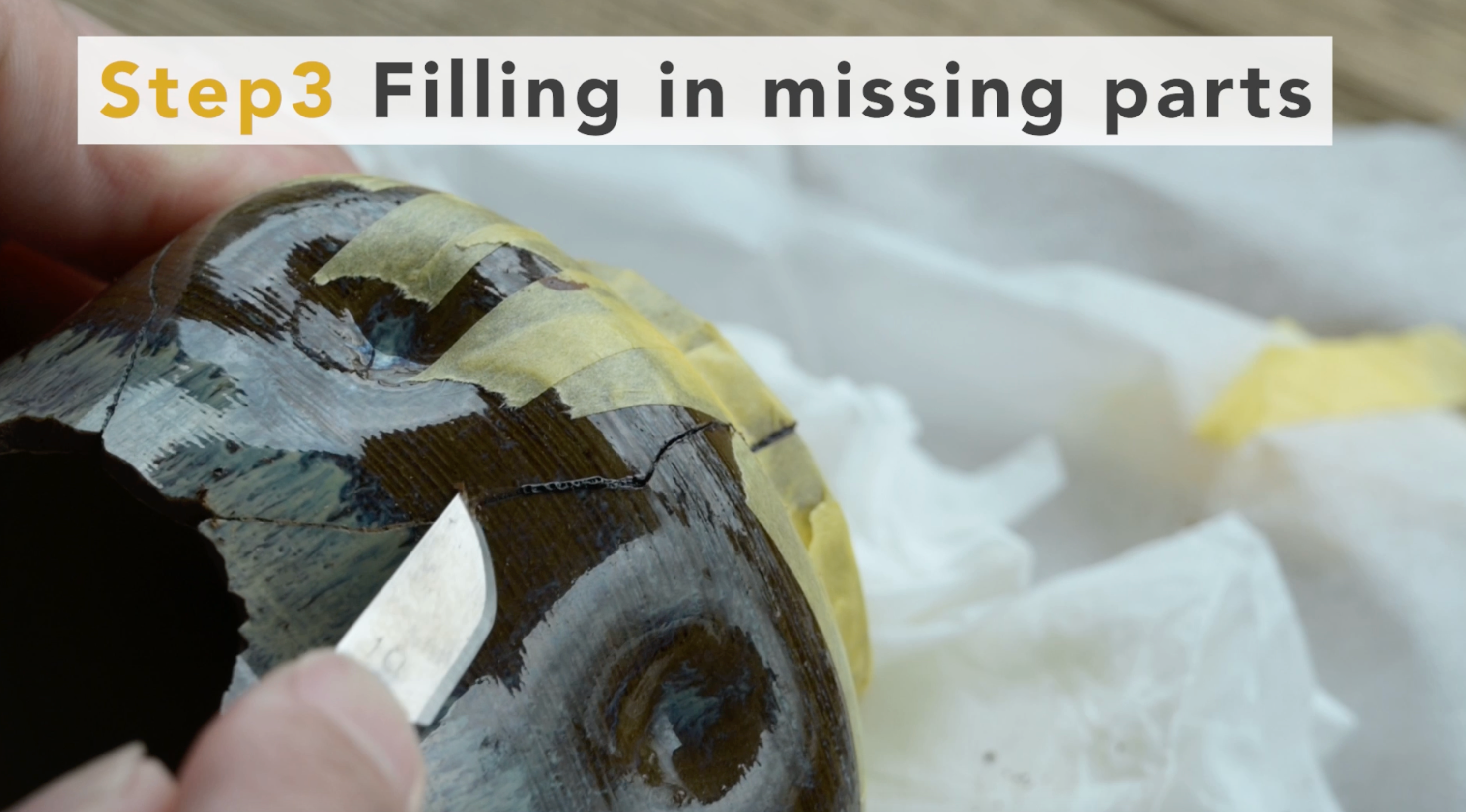
1. Scrape off excess Mugi-urushi
Once the gluing is firmly completed, wipe off any dirt on the surface of the ceramics with an ethanol-soaked tissue.
If hard mugi urushi still protrudes from the surface, scrape it off with a cutter.

2. Making "Kokuso-urushi"
Once excess mugi-urushi is removed, we will use "Kokuso-urushi" to fill the missing area.
In the Basic Tutorial, we used wood powder, but this time we will show you another way to make it.
It is easy to dry and strong even when applied thickly.
- Ingredients for Kokuso-Urushi
- Tonoko: 3 grated spoonful
- Jinoko: 1 grated spoonful
- Water: 1 grated spoonful
- Raw urushi: 2 grated spoonful
- Kokuso wata: 1 grated spoonful
- ※With 0.1ml measuring spoon
First, mix tonoko, jinoko and water on an acrylic board and knead.
Then add raw urushi and knead well with a spatula.
Finally, add Kokuso wata and knead to complete the process.
The kokuso-urushi dries quickly, so make it as small as possible and place the spatula on top to keep it out of the air.

3. Apply kokuso-urushi to the missing parts
Use Kokuso urushi to fill in the missing parts.
Thin glazed ceramics should have masking tape around them beforehand to prevent staining.
When applying kokuso urushi, keep the thickness to about 3mm at a time.
This is because if it is applied too thickly, the core may not harden.
For chips deeper than 4mm, repeat this step several times.
If kokuso urushi becomes dry, remake it.
If dry kokuso urushi is applied, it will be easier to peel off later.
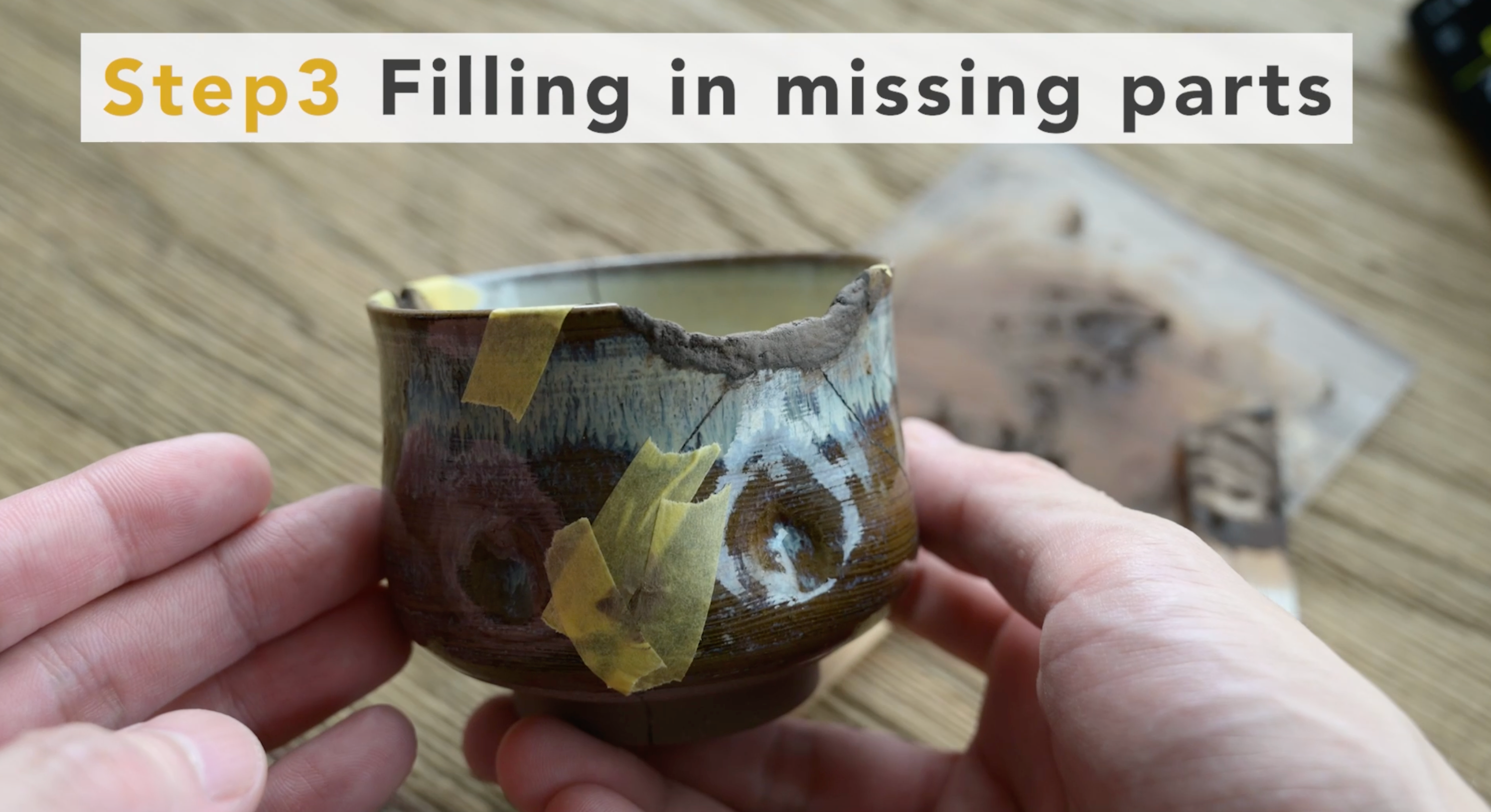
4. Wait about a few days to harden
Wait a few days for the kokuso-urushi to harden.
Repeat 1-4 process for any areas that were not filled in this time.
The kokuso-urushi does not need much humidity to harden, but it may not harden sufficiently in dry areas, for example.
To be safe, keep it in a place with a humidity of around 70% and a temperature of around 25 degrees Celsius.
- note
- One method is to place wet towels in cardboard boxes to maintain the right humidity for storage.
- The temperature should also be kept from getting cold by using air conditioning.
- In particular, urushi may not harden properly if the temperature falls below 20 degrees Celsius, so be careful to control both temperature and humidity after working on this and subsequent steps.

5. Scrape off excess Kokuso-urushi
When most of the missing areas are filled in, scrape it off with a cutter.
Thin stains should be wiped up with ethanol.
Shave it as much as possible to get as close to the original ceramics shape as possible.
The lacks will be filled in the next step, so now let's shave off the excess and shape it.
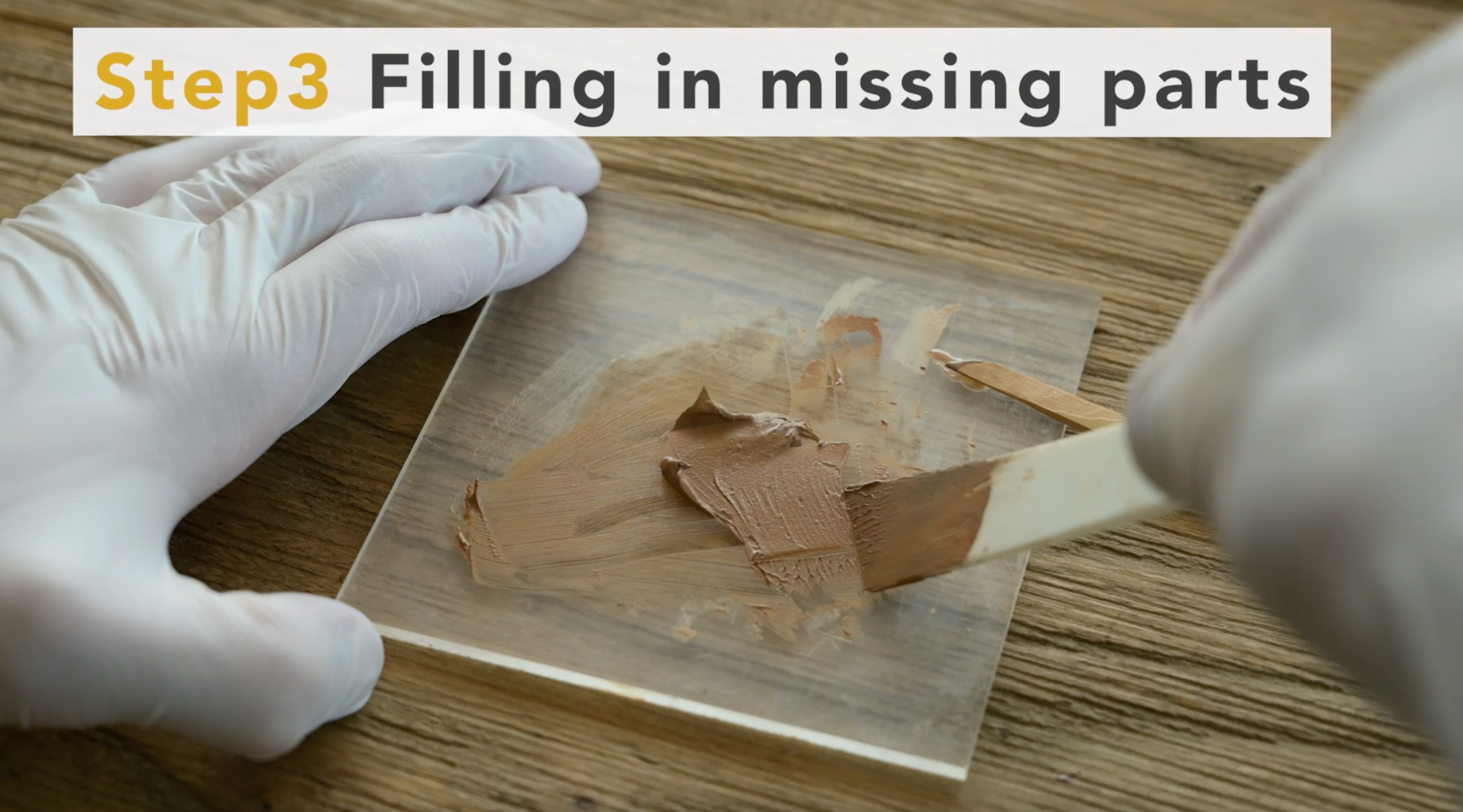
6. Making "Sabi-urushi"
Once excess kokuso-urushi is removed, we will use "Sabi-urushi" to fill the fine dents.
- Ingredients for Sabi-Urushi
- Tonoko: 2 grated spoonful
- Water: 1 grated spoonful
- Raw urushi: 1 grated spoonful
- ※With 0.1ml measuring spoon
First, take Tonoko on an acrylic plate, add water and mix them.
Then, add raw urushi and knead with a spatula.
The sabi-urushi dries quickly, so make it as small as possible and place the spatula on top to keep it out of the air.

7. Apply sabi-urushi
Then, apply sabi-urushi to the surface of the missing area.
※Use masking tape to protect unglazed pottery from stains.
The purpose of this step is to flatten the surface.
So, apply it so that no dents are left.
Normally, the grooves of the seams are also filled with sabi urushi.
However, since there is a possibility of staining ceramics, they will be filled with black urushi next time.
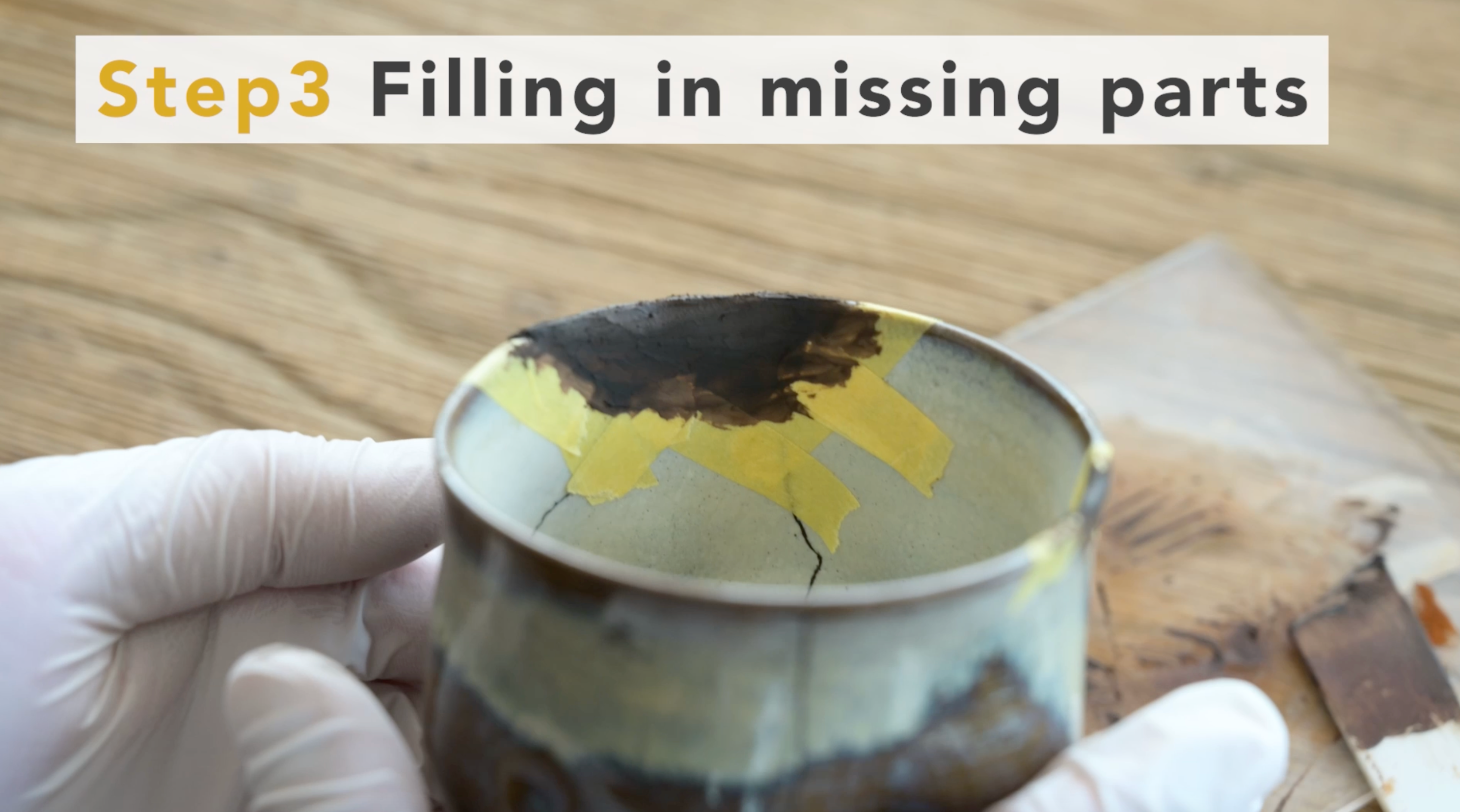
8. Wait a few days to harden
Wait a few days for the sabi-urushi to harden.
The sabi-urushi does not need much humidity to harden, but it may not harden sufficiently in dry areas, for example.
To be safe, keep it in a place with a humidity of around 70% and a temperature of around 25 degrees Celsius.
- Note
- If you try to fill large chips with sabi-urushi, only the surface of the sabi-urushi might dry, leaving the inside dull. If the groove is more than 1mm deep, use "Kokuso-urushi" used for chipped repair.
- note
- One method is to place wet towels in cardboard boxes to maintain the right humidity for storage.
- The temperature should also be kept from getting cold by using air conditioning.
- In particular, urushi may not harden properly if the temperature falls below 20 degrees Celsius, so be careful to control both temperature and humidity after working on this and subsequent steps.

How to wash tools
Wipe off any tools with urushi using a tissue moistened with ethanol.
All tools except for the brush can be wiped off with ethanol.
1. Scrape off excess Mugi-urushi
Once the gluing is firmly completed, wipe off any dirt on the surface of the ceramics with an ethanol-soaked tissue.
If hard mugi urushi still protrudes from the surface, scrape it off with a cutter.
2. Making "Kokuso-urushi"
Once excess mugi-urushi is removed, we will use "Kokuso-urushi" to fill the missing area.
In the Basic Tutorial, we used wood powder, but this time we will show you another way to make it.
It is easy to dry and strong even when applied thickly.
- Ingredients for Kokuso-Urushi
- Tonoko: 3 grated spoonful
- Jinoko: 1 grated spoonful
- Water: 1 grated spoonful
- Raw urushi: 2 grated spoonful
- Kokuso wata: 1 grated spoonful
- ※With 0.1ml measuring spoon
First, mix tonoko, jinoko and water on an acrylic board and knead.
Then add raw urushi and knead well with a spatula.
Finally, add Kokuso wata and knead to complete the process.
The kokuso-urushi dries quickly, so make it as small as possible and place the spatula on top to keep it out of the air.
3. Apply kokuso-urushi to the missing parts
Use Kokuso urushi to fill in the missing parts.
Thin glazed ceramics should have masking tape around them beforehand to prevent staining.
When applying kokuso urushi, keep the thickness to about 3mm at a time.
This is because if it is applied too thickly, the core may not harden.
For chips deeper than 4mm, repeat this step several times.
If kokuso urushi becomes dry, remake it.
If dry kokuso urushi is applied, it will be easier to peel off later.
4. Wait about a few days to harden
Wait a few days for the kokuso-urushi to harden.
Repeat 1-4 process for any areas that were not filled in this time.
The kokuso-urushi does not need much humidity to harden, but it may not harden sufficiently in dry areas, for example.
To be safe, keep it in a place with a humidity of around 70% and a temperature of around 25 degrees Celsius.
- note
- One method is to place wet towels in cardboard boxes to maintain the right humidity for storage.
- The temperature should also be kept from getting cold by using air conditioning.
- In particular, urushi may not harden properly if the temperature falls below 20 degrees Celsius, so be careful to control both temperature and humidity after working on this and subsequent steps.
5. Scrape off excess Kokuso-urushi
When most of the missing areas are filled in, scrape it off with a cutter.
Thin stains should be wiped up with ethanol.
Shave it as much as possible to get as close to the original ceramics shape as possible.
The lacks will be filled in the next step, so now let's shave off the excess and shape it.
6. Making "Sabi-urushi"
Once excess kokuso-urushi is removed, we will use "Sabi-urushi" to fill the fine dents.
- Ingredients for Sabi-Urushi
- Tonoko: 2 grated spoonful
- Water: 1 grated spoonful
- Raw urushi: 1 grated spoonful
- ※With 0.1ml measuring spoon
First, take Tonoko on an acrylic plate, add water and mix them.
Then, add raw urushi and knead with a spatula.
The sabi-urushi dries quickly, so make it as small as possible and place the spatula on top to keep it out of the air.
7. Apply sabi-urushi
Then, apply sabi-urushi to the surface of the missing area.
※Use masking tape to protect unglazed pottery from stains.
The purpose of this step is to flatten the surface.
So, apply it so that no dents are left.
Normally, the grooves of the seams are also filled with sabi urushi.
However, since there is a possibility of staining ceramics, they will be filled with black urushi next time.
8. Wait a few days to harden
Wait a few days for the sabi-urushi to harden.
The sabi-urushi does not need much humidity to harden, but it may not harden sufficiently in dry areas, for example.
To be safe, keep it in a place with a humidity of around 70% and a temperature of around 25 degrees Celsius.
- Note
- If you try to fill large chips with sabi-urushi, only the surface of the sabi-urushi might dry, leaving the inside dull. If the groove is more than 1mm deep, use "Kokuso-urushi" used for chipped repair.
- note
- One method is to place wet towels in cardboard boxes to maintain the right humidity for storage.
- The temperature should also be kept from getting cold by using air conditioning.
- In particular, urushi may not harden properly if the temperature falls below 20 degrees Celsius, so be careful to control both temperature and humidity after working on this and subsequent steps.
How to wash tools
Wipe off any tools with urushi using a tissue moistened with ethanol.
All tools except for the brush can be wiped off with ethanol.









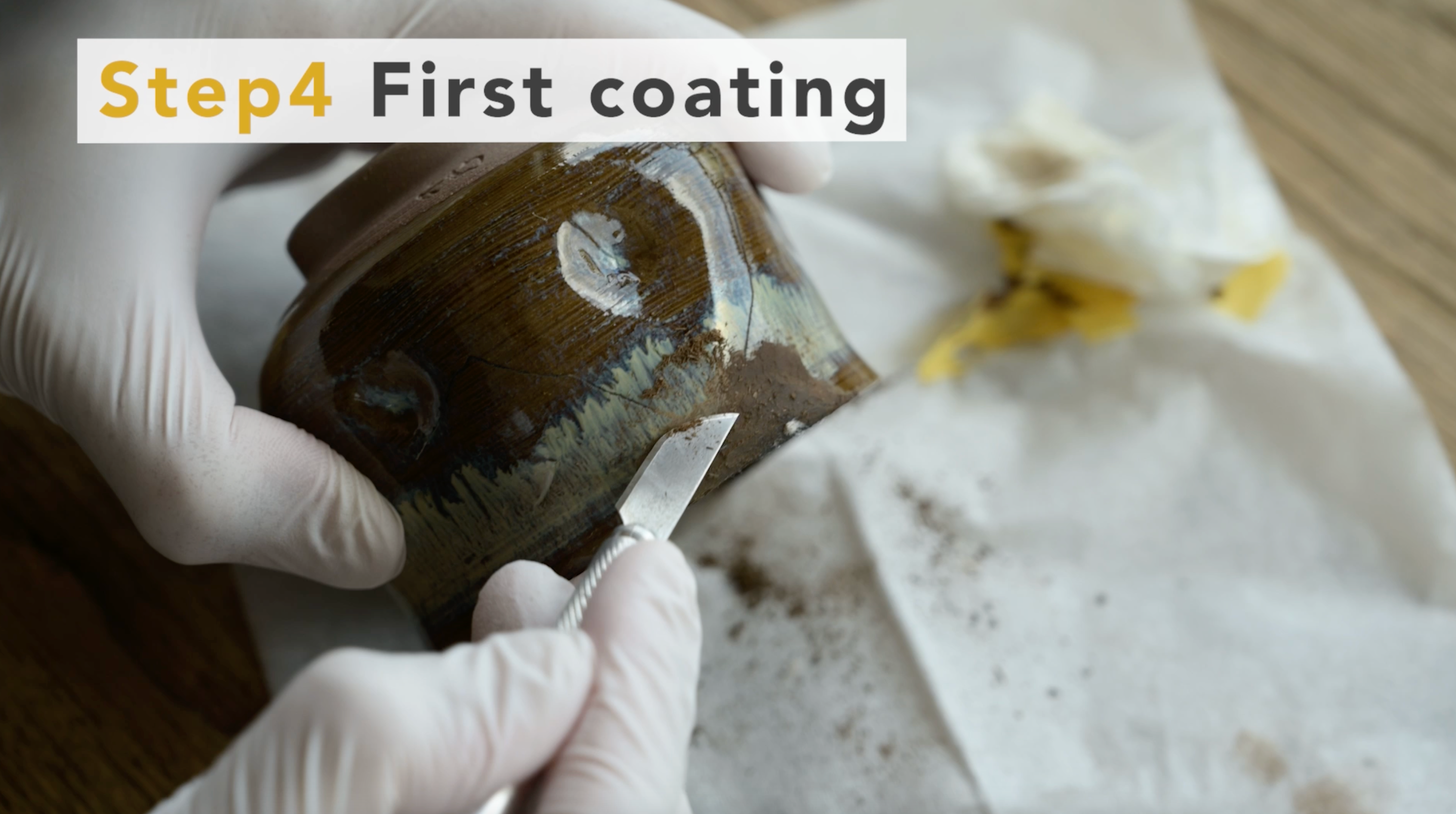
1. Scrape off the sabi-urushi
After the sabi-urushi has hardened, scrape off it on the overhangs with a cutter to make the seams flat and even.
If the surface is large and difficult to smooth with a cutter, use a sandpaper to smooth the surface as much as possible.
Wipe off any dirt on the surface of the ceramics with an ethanol-soaked tissue as appropriate.
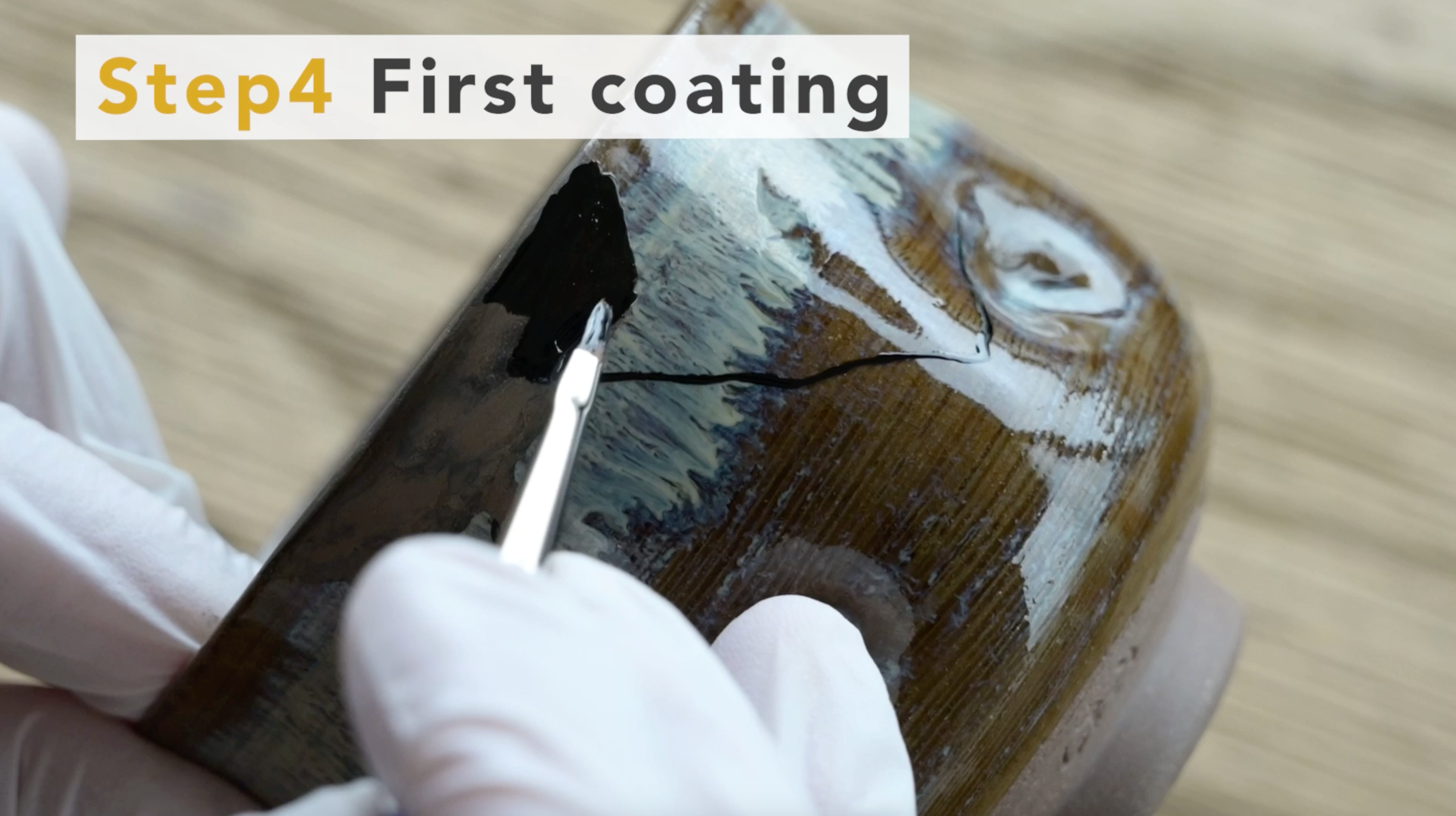
2. Coating the seams with "Black urushi"
Once the surface is smooth, apply black urushi.
Wipe the brush tip thoroughly with ethanol first before use.
It is recommended to apply the inside first because if you apply the outside first, you may touch the seam when applying the inside.
Apply a slightly thicker coat, with the intention of filling in the grooves.
Use a flat brush for chipped areas.

The purpose of this process is not to simply coat the seams, but to fill in the small dents by pouring black urushi into the seams to further flatten the surface.
Work as if you were "filling in the gaps with urushi" rather than "applying urushi".
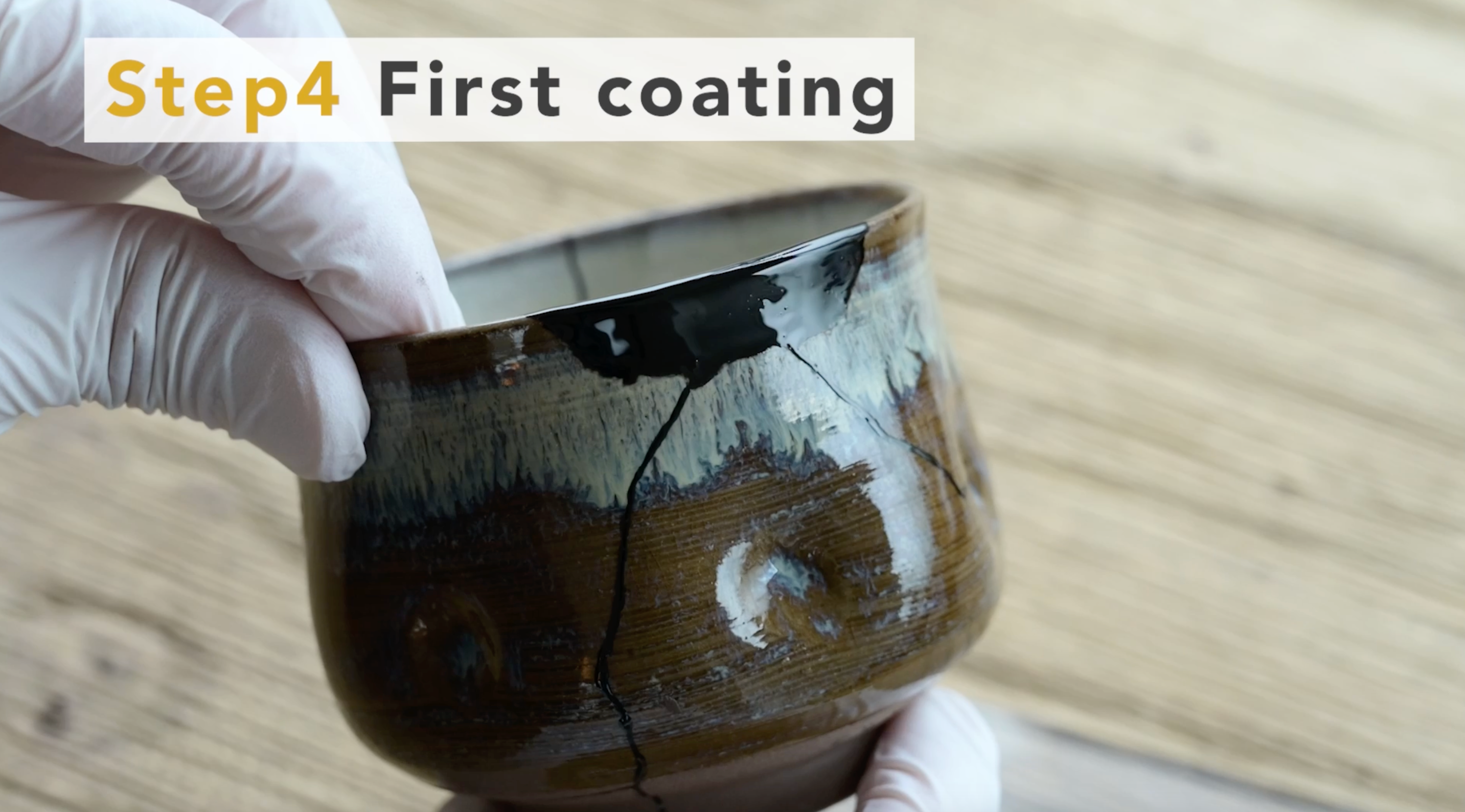
3. Wait few days to harden
When you have finished coating, leave it in the humid room and wait for a few days.
Also, keep the temperature around 25°C and the humidity around 70% because it will not harden if the temperature and humidity is too low.
On the other hand, too high a humidity of 80% or more is not good, as it may cause wrinkles when the urushi hardens.
- note
- One method is to place wet towels in cardboard boxes to maintain the right humidity for storage.
- The temperature should also be kept from getting cold by using air conditioning.
- In particular, urushi may not harden properly if the temperature falls below 20 degrees Celsius, so be careful to control both temperature and humidity after working on this and subsequent steps.

How to wash brushes
Wash brushes after use with vegetable oil such as rapeseed oil.
Dip the brush into the oil that has been put out on the acrylic plate and wipe it off with a tissue.
Repeat this process until there is almost no color on the tissue.
Finally, put the cap on and store the brush with a little oil remaining on it.
Otherwise, the brush tip may harden.
Finally, completely wipe off any oil remaining on the acrylic plate with ethanol.
If even a small amount of oil is left, it may mix with the oil and prevent the urushi from hardening next time.
1. Scrape off the sabi-urushi
After the sabi-urushi has hardened, scrape off it on the overhangs with a cutter to make the seams flat and even.
If the surface is large and difficult to smooth with a cutter, use a sandpaper to smooth the surface as much as possible.
Wipe off any dirt on the surface of the ceramics with an ethanol-soaked tissue as appropriate.
2. Coating the seams with "Black urushi"
Once the surface is smooth, apply black urushi.
Wipe the brush tip thoroughly with ethanol first before use.
It is recommended to apply the inside first because if you apply the outside first, you may touch the seam when applying the inside.
Apply a slightly thicker coat, with the intention of filling in the grooves.
Use a flat brush for chipped areas.
The purpose of this process is not to simply coat the seams, but to fill in the small dents by pouring black urushi into the seams to further flatten the surface.
Work as if you were "filling in the gaps with urushi" rather than "applying urushi".
3. Wait few days to harden
When you have finished coating, leave it in the humid room and wait for a few days.
Also, keep the temperature around 25°C and the humidity around 70% because it will not harden if the temperature and humidity is too low.
On the other hand, too high a humidity of 80% or more is not good, as it may cause wrinkles when the urushi hardens.
- note
- One method is to place wet towels in cardboard boxes to maintain the right humidity for storage.
- The temperature should also be kept from getting cold by using air conditioning.
- In particular, urushi may not harden properly if the temperature falls below 20 degrees Celsius, so be careful to control both temperature and humidity after working on this and subsequent steps.
How to wash brushes
Wash brushes after use with vegetable oil such as rapeseed oil.
Dip the brush into the oil that has been put out on the acrylic plate and wipe it off with a tissue.
Repeat this process until there is almost no color on the tissue.
Finally, put the cap on and store the brush with a little oil remaining on it.
Otherwise, the brush tip may harden.
Finally, completely wipe off any oil remaining on the acrylic plate with ethanol.
If even a small amount of oil is left, it may mix with the oil and prevent the urushi from hardening next time.






1. Polish the seams with an abrasive sheets
After the first coat of black urushi dries, polish the seams using soft abrasive sheets.
The polishing sheet is soft and fine-grained, so it will not scratch the glaze even if it is polished directly.
However, the gilding and painting may come off, so protect it with masking tape beforehand.
When the seams are flat enough that you can run your finger over them and not feel any bumps, wipe with ethanol.
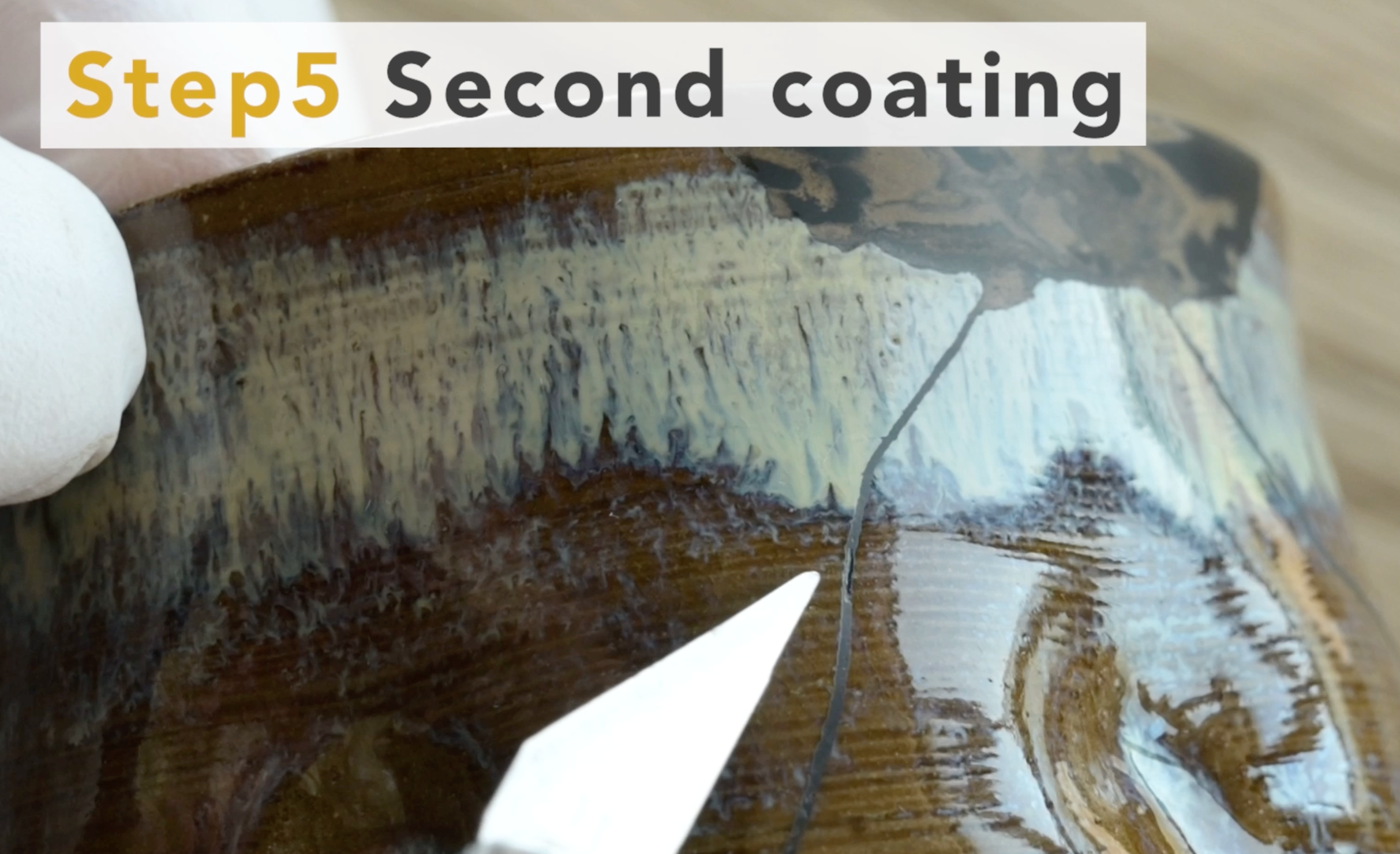
2. Coating with black urushi
Once polished, in many cases grooves and wrinkles still remain.
In such cases, coat the surface again using the same procedure as step 4.
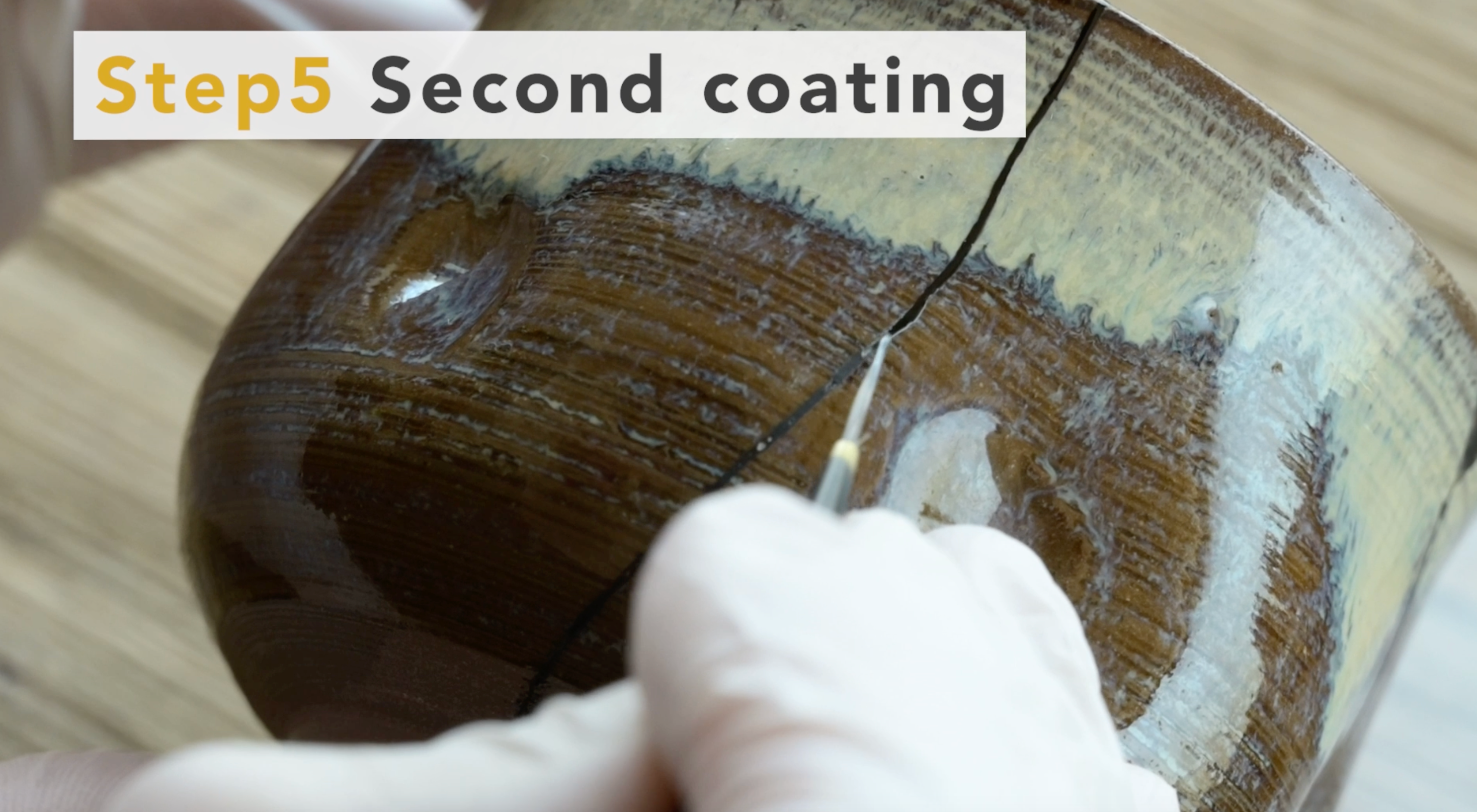
Wipe the brush tip thoroughly with ethanol first before use.
It is recommended that the entire area be reapplied, not just the grooved areas.
This is because there may be fine grooves that are not visible to the eye.
For visible grooves, apply a slightly thicker coat to fill them in.
- Tips
- In this procedure, the coating process has been applied twice, but basically the coating process is repeated until the seams are flat. Conversely, if the work is finished beautifully at the point of the first coat, the 2nd coat may not be applied.

3. Wait few days to harden
When you have finished coating, leave it in the humid room and wait for a few days.
Also, keep the temperature around 25°C and the humidity around 70% because it will not harden if the temperature and humidity is too low.
On the other hand, too high a humidity of 80% or more is not good, as it may cause wrinkles when the urushi hardens.
- note
- One method is to place wet towels in cardboard boxes to maintain the right humidity for storage.
- The temperature should also be kept from getting cold by using air conditioning.
- In particular, urushi may not harden properly if the temperature falls below 20 degrees Celsius, so be careful to control both temperature and humidity after working on this and subsequent steps.

How to wash brushes
Wash brushes after use with vegetable oil such as rapeseed oil.
Dip the brush into the oil that has been put out on the acrylic plate and wipe it off with a tissue.
Repeat this process until there is almost no color on the tissue.
Finally, put the cap on and store the brush with a little oil remaining on it.
Otherwise, the brush tip may harden.
Finally, completely wipe off any oil remaining on the acrylic plate with ethanol.
If even a small amount of oil is left, it may mix with the oil and prevent the urushi from hardening next time.
1. Polish the seams with an abrasive sheets
After the first coat of black urushi dries, polish the seams using soft abrasive sheets.
The polishing sheet is soft and fine-grained, so it will not scratch the glaze even if it is polished directly.
However, the gilding and painting may come off, so protect it with masking tape beforehand.
When the seams are flat enough that you can run your finger over them and not feel any bumps, wipe with ethanol.
2. Coating with black urushi
Once polished, in many cases grooves and wrinkles still remain.
In such cases, coat the surface again using the same procedure as step 4.
Wipe the brush tip thoroughly with ethanol first before use.
It is recommended that the entire area be reapplied, not just the grooved areas.
This is because there may be fine grooves that are not visible to the eye.
For visible grooves, apply a slightly thicker coat to fill them in.
- Tips
- In this procedure, the coating process has been applied twice, but basically the coating process is repeated until the seams are flat. Conversely, if the work is finished beautifully at the point of the first coat, the 2nd coat may not be applied.
3. Wait few days to harden
When you have finished coating, leave it in the humid room and wait for a few days.
Also, keep the temperature around 25°C and the humidity around 70% because it will not harden if the temperature and humidity is too low.
On the other hand, too high a humidity of 80% or more is not good, as it may cause wrinkles when the urushi hardens.
- note
- One method is to place wet towels in cardboard boxes to maintain the right humidity for storage.
- The temperature should also be kept from getting cold by using air conditioning.
- In particular, urushi may not harden properly if the temperature falls below 20 degrees Celsius, so be careful to control both temperature and humidity after working on this and subsequent steps.
How to wash brushes
Wash brushes after use with vegetable oil such as rapeseed oil.
Dip the brush into the oil that has been put out on the acrylic plate and wipe it off with a tissue.
Repeat this process until there is almost no color on the tissue.
Finally, put the cap on and store the brush with a little oil remaining on it.
Otherwise, the brush tip may harden.
Finally, completely wipe off any oil remaining on the acrylic plate with ethanol.
If even a small amount of oil is left, it may mix with the oil and prevent the urushi from hardening next time.





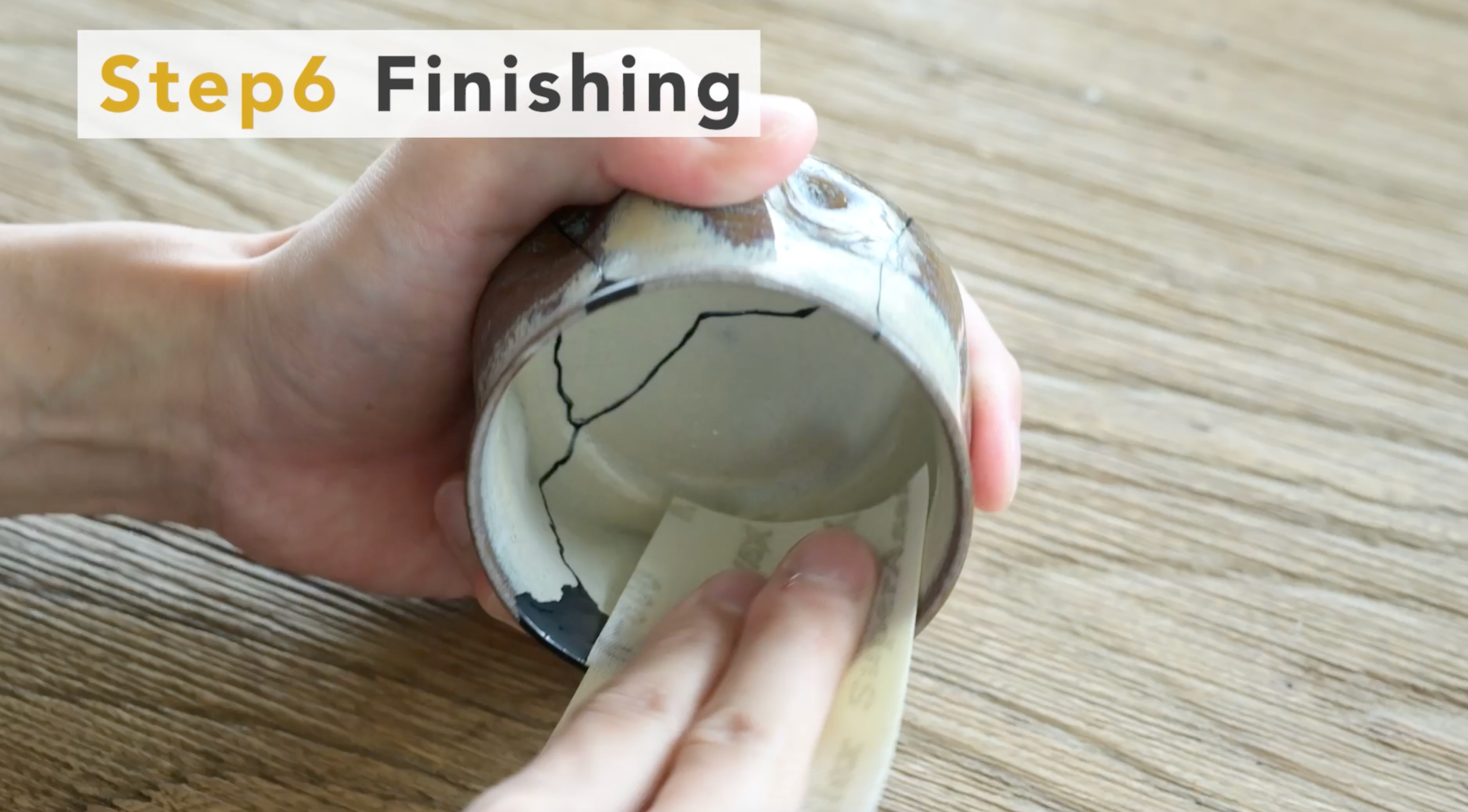
1. Polish the seams with an abrasive sheet
After the 2nd coat of black urushi dries, polish the seams using an abrasive sheet.
The polishing sheet is soft and fine-grained, so it will not scratch the glaze even if it is polished directly.
However, the painting may come off, so protect it with masking tape beforehand.
When the seams are flat enough that you can run your finger over them and not feel any bumps, wipe the whole thing down with ethanol.

2. Apply a thin coat of Bengara-urushi
Once the seams are in place, it is time to prepare for applying gold powder.
First, a "thin" layer of bengara-urushi is applied to the seams.
Be careful not to apply it too thickly, otherwise the gold powder will sink into the bengara urushi.
- Tips for applying thin coat
- Put a little bengara urushi on the brush tip.
- Move the brush slowly.
- Do not add more bengara urushi until the bengara urushi becomes faint.
If you add bengara urushi to the tip frequently, it will be applied too thickly.
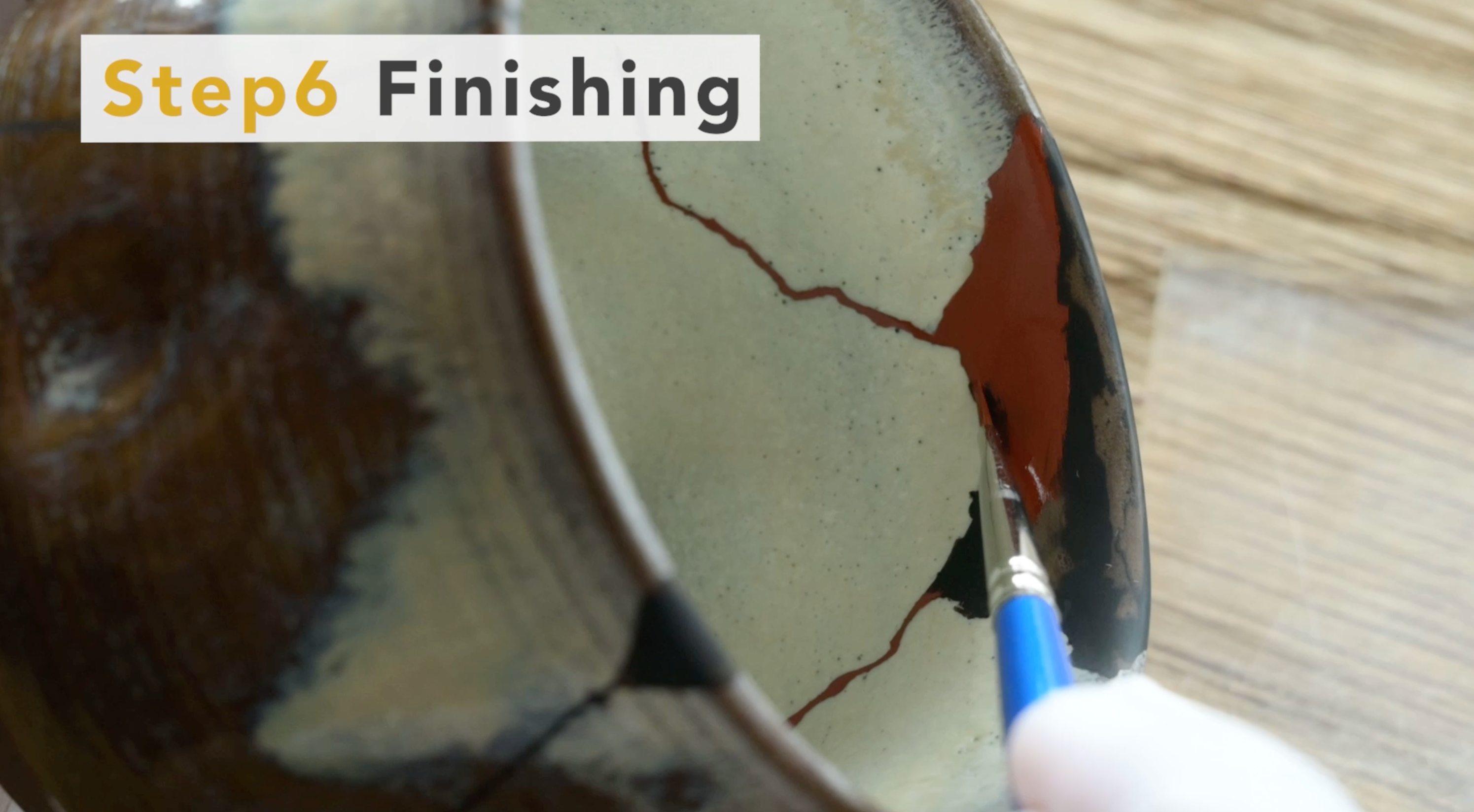
Apply the same thin coat to the chipped area with a flat brush.
Placing gold on top of red will improve the color of gold, so bengara urushi is used.
If the undercoat is black, it will be easier to find unpainted areas when the bengara urushi is applied.
So until the previous process, black urushi was painted.
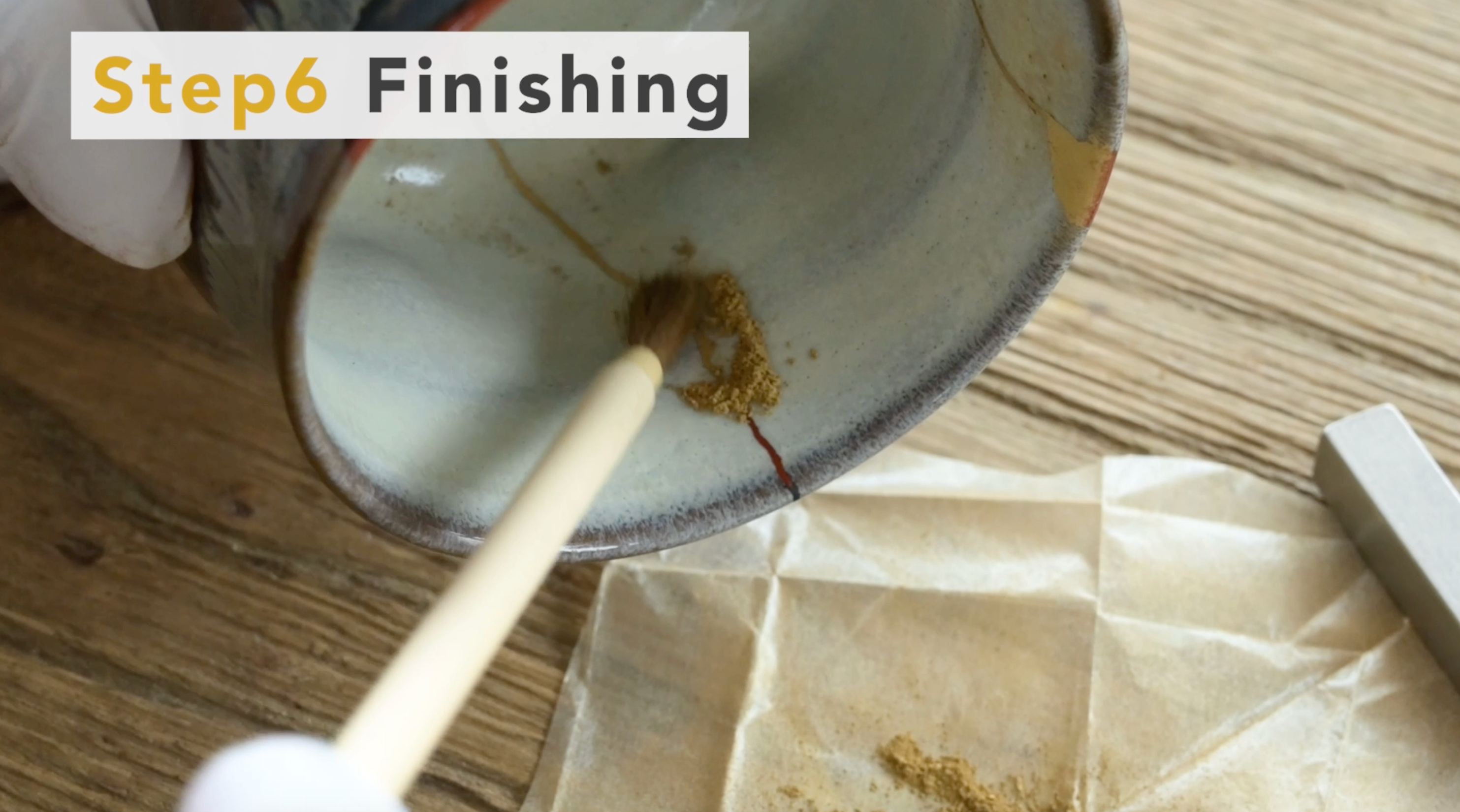
3. Apply gold powder on the seams
After applying bengara-urushi, apply gold powder.
In the basic tutorial, we used cotton from the beginning, but this time we will use ashirai brush first.
First, add a lot of powder to the tip of the brush.
Then lightly tap the brush to drop the powder around the seam.
Apply powder to the seam while brushing off the surrounding powder with a brush.
Be careful not to touch urushi with a brush.
The only thing that touches bengara urushi is the powder moved by the brush.
Once the area has been powdered, it is safe for the brush to touch it.
Even then, the brush should be laid down slightly to gently touch the seam.

Once the entire area is covered with powder, the next step is to finish with cotton.
Put generous amount of gold powder on a cotton ball and move the cotton ball in small circles over the seams.
This will give it more luster.
- Tips
- Be careful that the cotton itself does not touch urushi.
- Ideally, only the gold powder on the cotton should touch the urushi.
- The key is to apply gently and with as little force as possible.
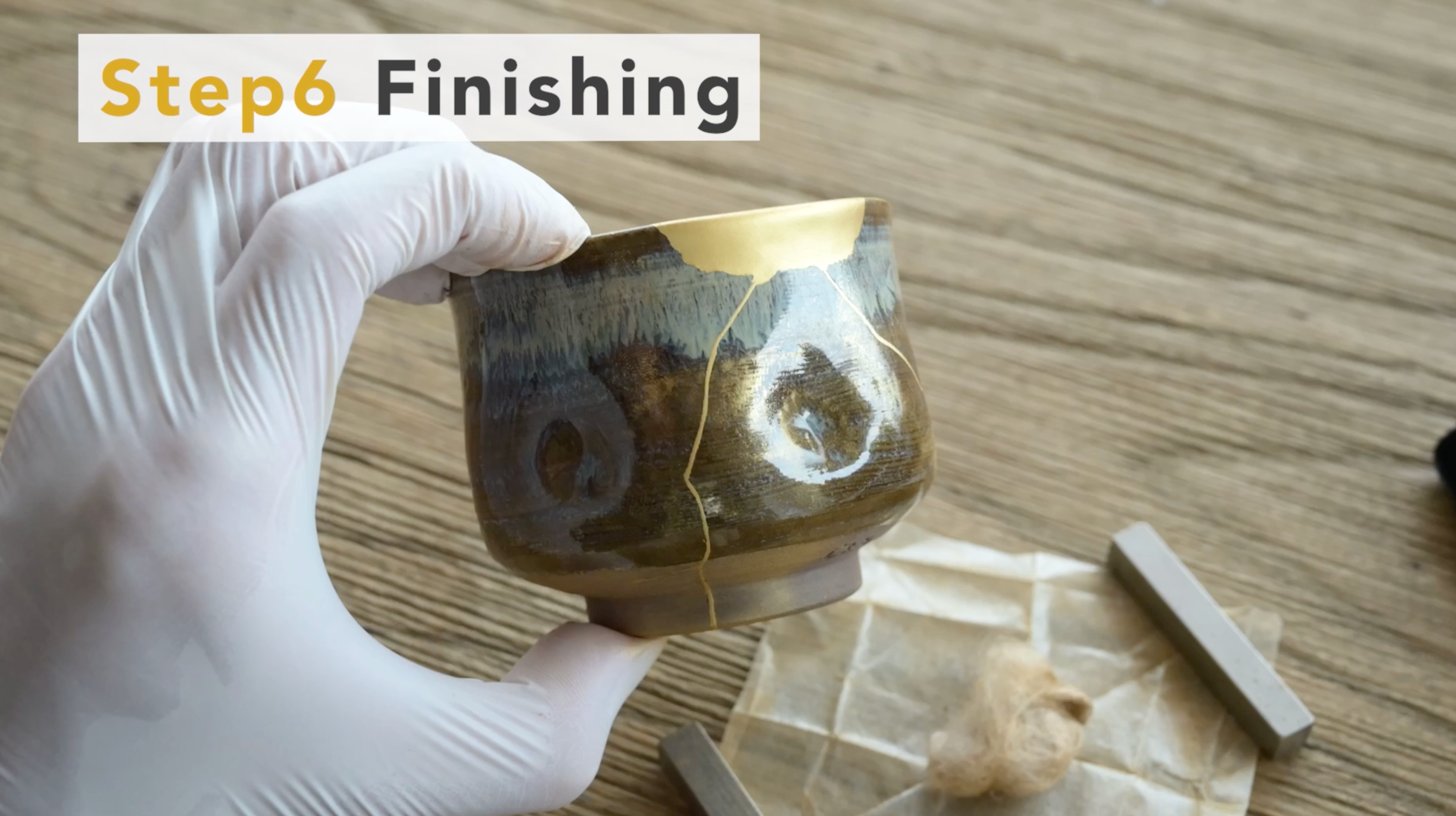
4. Wait about a week to harden
When you have finished applying, leave it in the humid room and wait for a few days.
Also, keep the temperature around 25°C and the humidity around 70% because it will not harden if the temperature and humidity is too low.
On the other hand, too high a humidity of 80% or more is not good, as it may cause wrinkles when the urushi hardens.
- Tips
- When washing the ashirai brush, wipe them down with ethanol, not oil.
- note
- One method is to place wet towels in cardboard boxes to maintain the right humidity for storage.
- The temperature should also be kept from getting cold by using air conditioning.
- In particular, urushi may not harden properly if the temperature falls below 20 degrees Celsius, so be careful to control both temperature and humidity after working on this and subsequent steps.
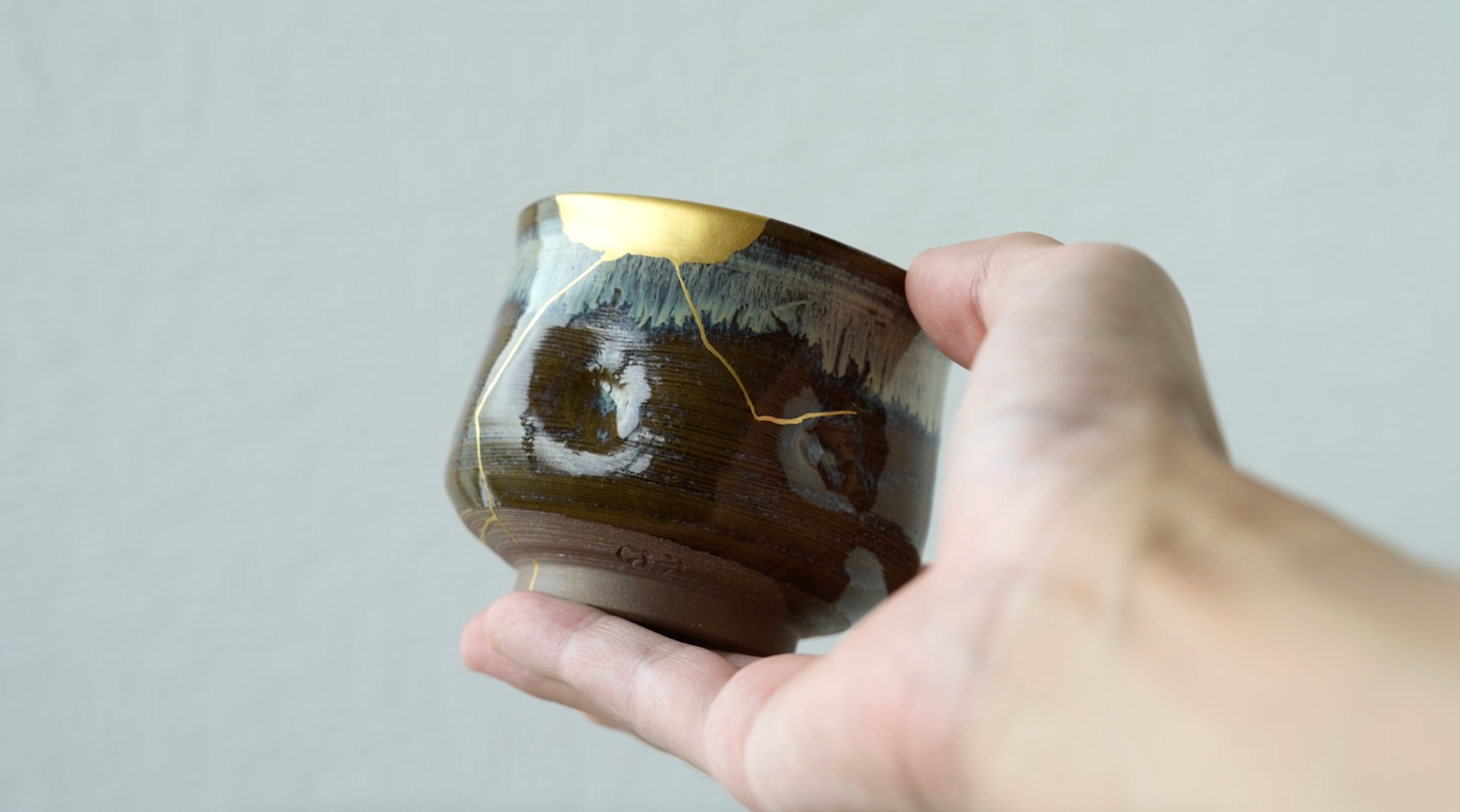
5. Completion
After one to two weeks in the urushi room, the bengara urushi hardens and the gold powder is fixed to the seams.
Wipe off the surface with a wet wipe to complete the process.
At this time, wipe with water, not ethanol.
Wiping with ethanol may remove even gold powder.
1. Polish the seams with an abrasive sheet
After the 2nd coat of black urushi dries, polish the seams using an abrasive sheet.
The polishing sheet is soft and fine-grained, so it will not scratch the glaze even if it is polished directly.
However, the painting may come off, so protect it with masking tape beforehand.
When the seams are flat enough that you can run your finger over them and not feel any bumps, wipe the whole thing down with ethanol.
2. Apply a thin coat of Bengara-urushi
Once the seams are in place, it is time to prepare for applying gold powder.
First, a "thin" layer of bengara-urushi is applied to the seams.
Be careful not to apply it too thickly, otherwise the gold powder will sink into the bengara urushi.
- Tips for applying thin coat
- Put a little bengara urushi on the brush tip.
- Move the brush slowly.
- Do not add more bengara urushi until the bengara urushi becomes faint.
If you add bengara urushi to the tip frequently, it will be applied too thickly.
Apply the same thin coat to the chipped area with a flat brush.
Placing gold on top of red will improve the color of gold, so bengara urushi is used.
If the undercoat is black, it will be easier to find unpainted areas when the bengara urushi is applied.
So until the previous process, black urushi was painted.
3. Apply gold powder on the seams
After applying bengara-urushi, apply gold powder.
In the basic tutorial, we used cotton from the beginning, but this time we will use ashirai brush first.
First, add a lot of powder to the tip of the brush.
Then lightly tap the brush to drop the powder around the seam.
Apply powder to the seam while brushing off the surrounding powder with a brush.
Be careful not to touch urushi with a brush.
The only thing that touches bengara urushi is the powder moved by the brush.
Once the area has been powdered, it is safe for the brush to touch it.
Even then, the brush should be laid down slightly to gently touch the seam.
Once the entire area is covered with powder, the next step is to finish with cotton.
Put generous amount of gold powder on a cotton ball and move the cotton ball in small circles over the seams.
This will give it more luster.
- Tips
- Be careful that the cotton itself does not touch urushi.
- Ideally, only the gold powder on the cotton should touch the urushi.
- The key is to apply gently and with as little force as possible.
4. Wait about a week to harden
When you have finished applying, leave it in the humid room and wait for a few days.
Also, keep the temperature around 25°C and the humidity around 70% because it will not harden if the temperature and humidity is too low.
On the other hand, too high a humidity of 80% or more is not good, as it may cause wrinkles when the urushi hardens.
- Tips
- When washing the ashirai brush, wipe them down with ethanol, not oil.
- note
- One method is to place wet towels in cardboard boxes to maintain the right humidity for storage.
- The temperature should also be kept from getting cold by using air conditioning.
- In particular, urushi may not harden properly if the temperature falls below 20 degrees Celsius, so be careful to control both temperature and humidity after working on this and subsequent steps.
5. Completion
After one to two weeks in the urushi room, the bengara urushi hardens and the gold powder is fixed to the seams.
Wipe off the surface with a wet wipe to complete the process.
At this time, wipe with water, not ethanol.
Wiping with ethanol may remove even gold powder.







Standard Kit
Lesson 04: Combined breakage

Leave a comment
All comments are moderated before being published.
This site is protected by reCAPTCHA and the Google Privacy Policy and Terms of Service apply.